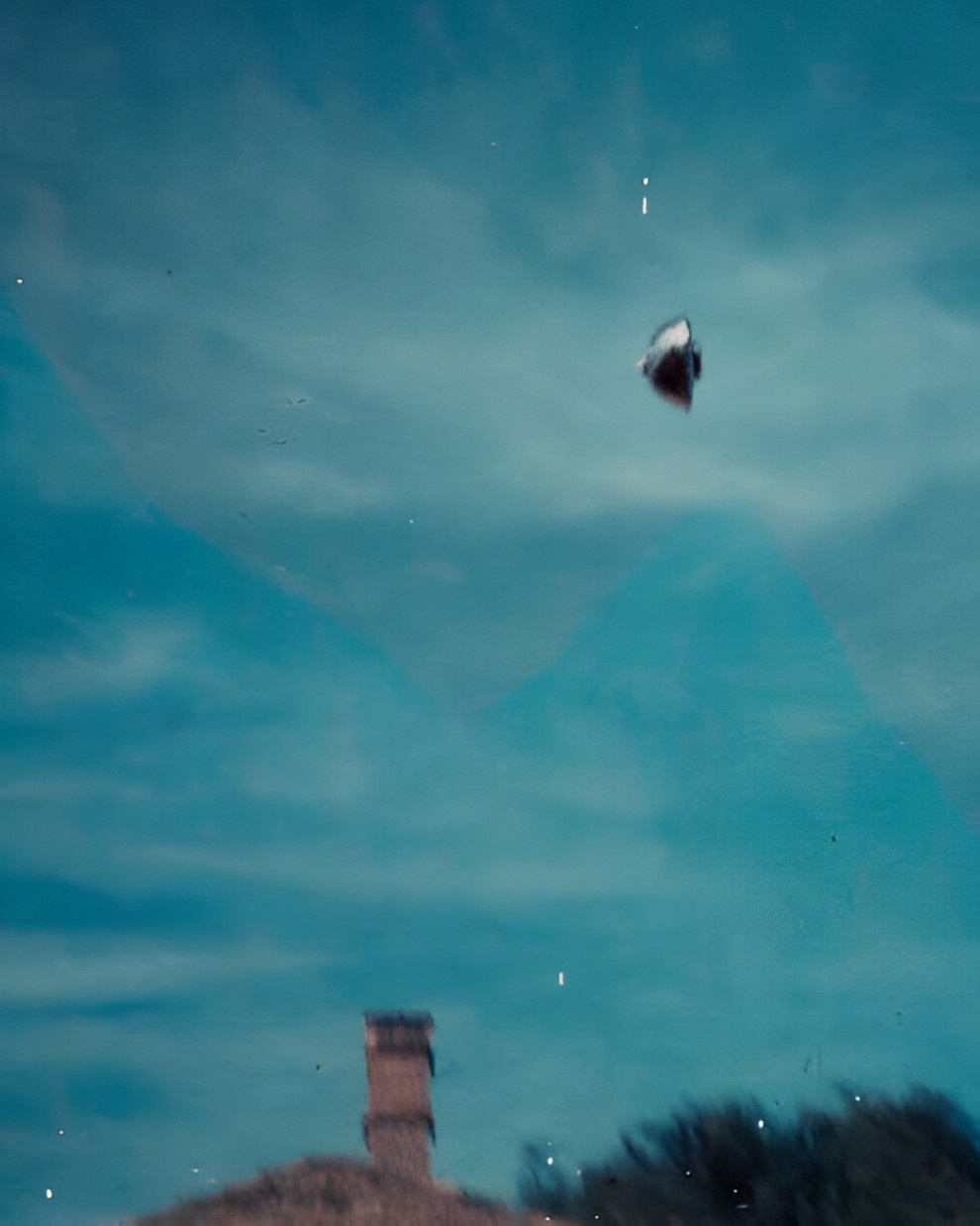Best UFO Photos of All Time
When people talk UFOs, it always comes back to the same lines: “Show me the evidence” or “Why are the photos always so blurry?”
Well, I’ve got news for the skeptics. There are plenty of clear-as-day UFO photos out there, and I’m dropping some of them below. But let’s be real, you’ll probably still wave them off in full Mick West mode: “clearly a seagull,” “probably a dinner plate,” “parallax of a shiny hubcap cloud during a freak weather event.” Honestly, there’s just no pleasing you lot.
What follows are some of the classics, the photos that have been passed around the longest. No blurry Starlink dots, but genuine UFO shots that still spark debate. Sure, some might be fake, but who cares? They’ve been in circulation for decades, and one of them might just be the real deal.
Each has its own backstory: who snapped it, what they claimed, and how it’s been argued over ever since. Some have solid debunks, others flimsy ones, and a few remain just as strange today as the day they were taken. The point here isn’t to settle the argument. It’s to show the images that refuse to fade, the ones people keep pointing to and can’t quite dismiss.
And remember, it only takes one of them being genuine to change everything.
National Geographic Institute of Costa Rica – 1971
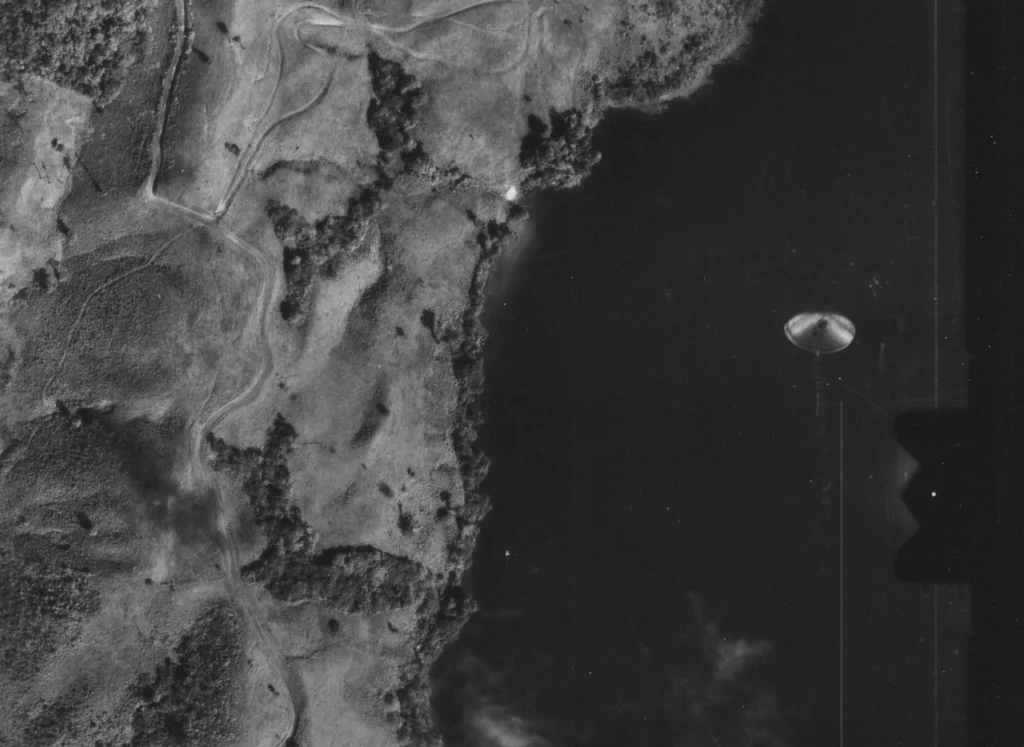
In September 1971, a National Geographic Institute plane was flying survey runs over Lake Cote with a mapping camera fixed under the fuselage. The camera was set to fire automatically, frame after frame, to capture the terrain below for cartographic work. Nothing unusual was noticed at the time. But when the film was developed, one image revealed a disc hovering over the lake.
The object is sharply defined: oval, metallic-looking, with highlights and shadows that make it appear three-dimensional and solid. Unlike the blurred streaks or dots that make up most UFO photographs of that era, this one looks like an actual craft suspended in daylight. Because the image came from a government mapping project with no link to UFO research, it has long been considered one of the more credible anomalies on record. Skeptics point out the possibility of film blemishes, but the precision of the mapping cameras and the object’s clean outline keep it ranked as one of the most intriguing UFO photos ever taken.
Weyauwega, Wisconsin – Feb 1, 2003
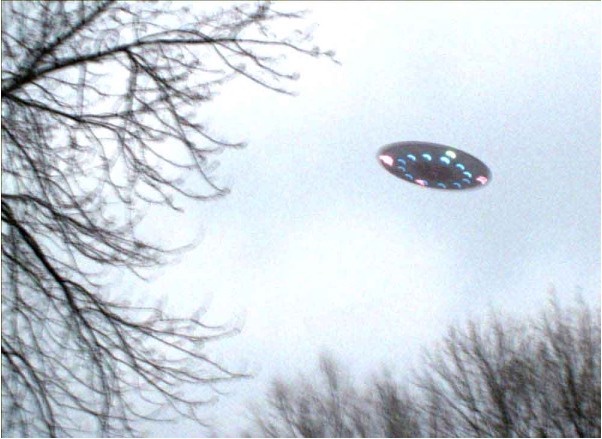
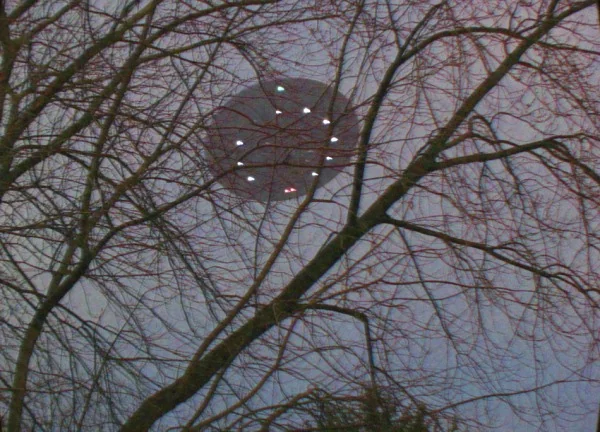
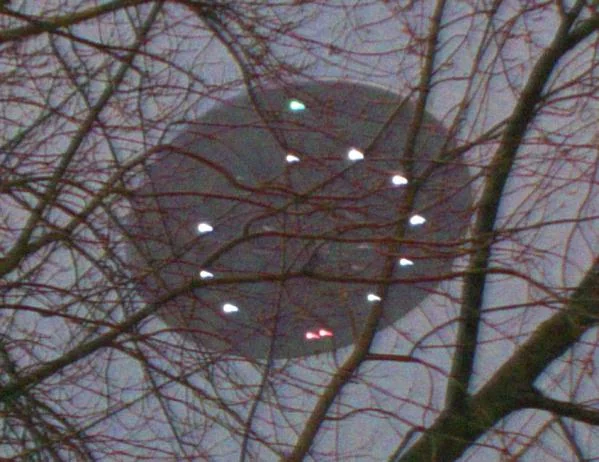
On a cold February evening in 2003, a mother and her son were sledding in Weyauwega, Wisconsin when the boy pointed out unusual lights moving across the sky from the southwest. The mother, carrying her camera, managed to snap several photos in quick succession. What she captured shows a saucer-like object with bright, multi-colored lights on its underside, arranged in a loose triangular pattern. Witnesses said the lights seemed to shift or cycle as the object moved.
Unlike many UFO cases that hinge on a single blurry frame, this one provided a short sequence of images, each reinforcing the last. The location—just north of Main Street, east of Highway 110, near the train tracks—anchors the event in a recognizable place, and the timing at late dusk explains the deep sky tones in the photos. While skeptics have suggested balloons or camera reflections, the clear saucer profile combined with the colored lights has made the Weyauwega case a favorite among collectors of modern UFO photographs. The witness remained anonymous, and no other locals came forward, but the photos continue to circulate widely as one of the sharper captures of the early 2000s.
Vancouver Island, Canada – 1981
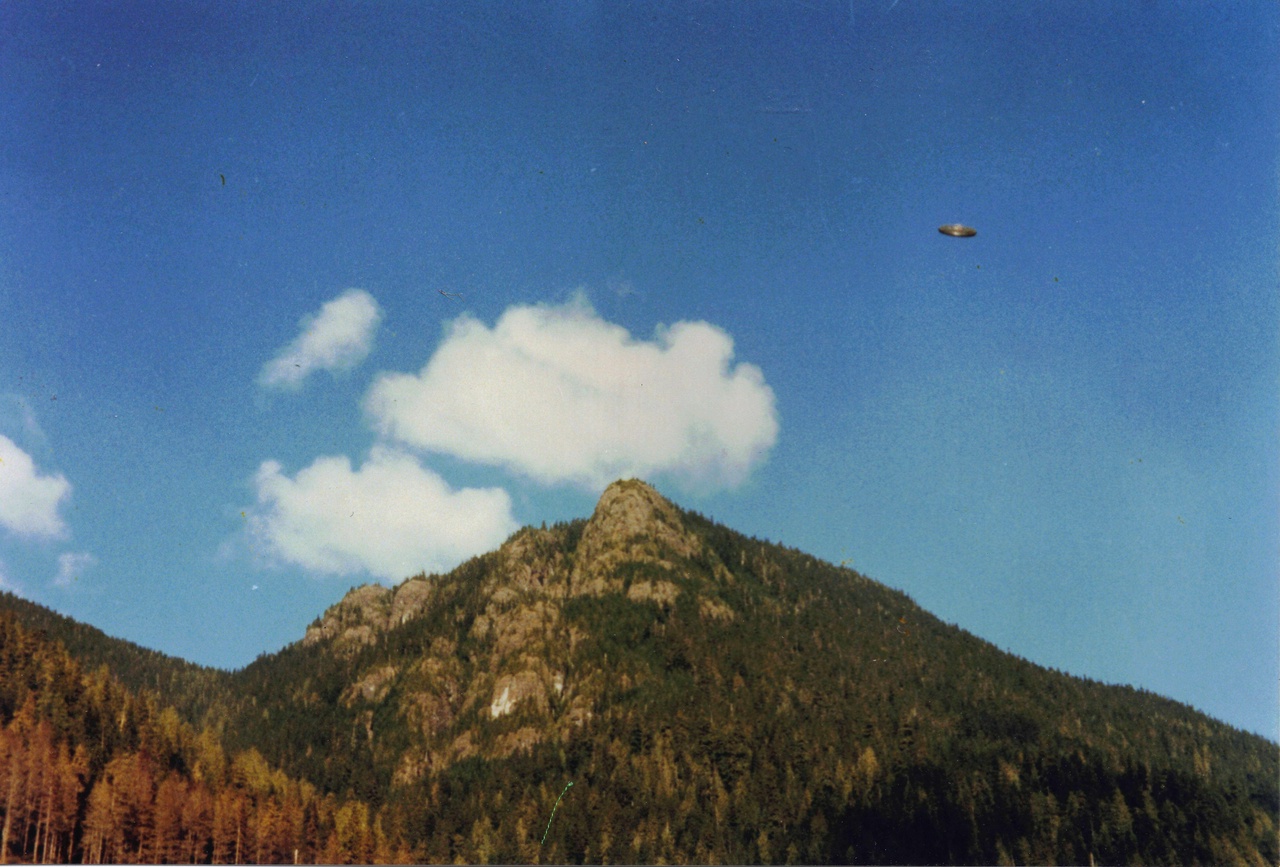
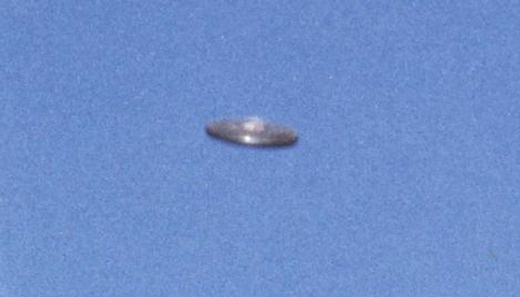
In October 1981 Hannah McRoberts was traveling near Kelsey Bay on Vancouver Island when she stopped to take a photograph of a mountain scene. She did not notice anything odd at the time, but when the film was developed one frame stood out. Above the peak and near a plume of cloud was a clear disc-shaped object, suspended in the sky.
The photograph was studied closely and tests such as micro-densitometry found no signs of tampering. There were no strings, no double exposures, and no obvious lens defects. The object looks solid but slightly diffuse, with less brightness than the clouds around it, as though it was reflecting light at a distance. It does not resemble a bird or an aircraft. Estimates suggest it may have been at least thirty feet across.
The main weakness of the case is that McRoberts did not see the object in real time. There is only the one photo, no direct sighting, and no corroborating witnesses. Even so, the clean setting, the technical checks, and the absence of obvious fakery have made this image one of the most enduring Canadian UFO cases. It shows how even a casual snapshot can sometimes capture something extraordinary.
Calvine, Scotland – 1990
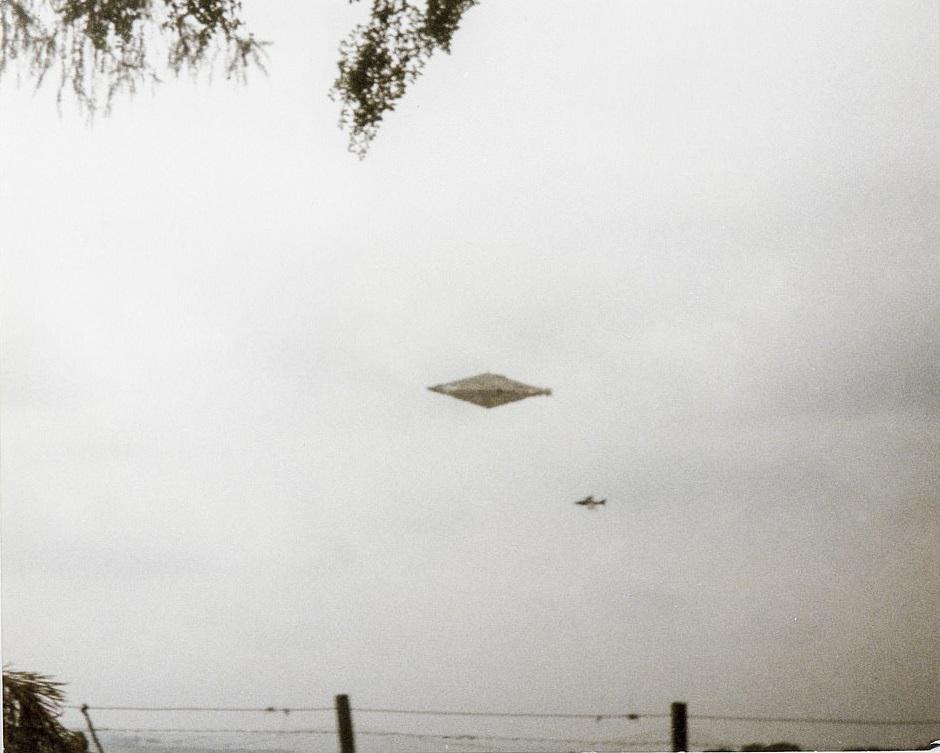
On the evening of August 4, 1990 two men hiking near Calvine in Perthshire reported a huge diamond-shaped object hanging silently in the sky. They said it stayed motionless for several minutes before shooting straight upward at incredible speed. In that time they managed to take six photographs, though only one has survived in circulation.
The surviving image shows a sharp diamond form with no wings, tail, or engines. Below it appears to be a jet, possibly a Harrier, which gives a sense of scale and suggests that military aircraft may have been observing the scene. The Ministry of Defence studied the case, found no proof of a hoax, and filed it as unexplained.
Unfortunately, the negatives and most of the prints disappeared and the two witnesses never went public. These missing pieces fuel debate and suspicion. Some suggest a secret aircraft test, others an optical illusion, and some hold it was genuinely unknown. Whatever the truth, the Calvine photo remains one of the most striking and debated UFO images in existence.
Balwyn, Melbourne, Australia – 1966
On April 2, 1966 James Kibel used a Polaroid camera to take a photograph from his mother’s garden in the Melbourne suburb of Balwyn. The image shows a metallic bell-shaped object above rooftop. What makes it unusual is that reflections on the object seem to match details of the environment, such as red-tiled roofs and nearby foliage.
The reflections suggest the object was above the houses and not a small item tossed near the lens. One observer even estimated it would have to be at least as wide as a chimney to produce the reflections visible. That makes it much larger than a toy or hubcap.
Skeptics argue that it could have been a reflection, a pram wheel, a mounted bell, or a hoax involving montage techniques. Others note the timing, just days before the Westall school sighting, which makes the photo part of a broader pattern of activity in the area. Whatever its origin, the Balwyn image remains one of Australia’s more puzzling UFO photos.
U.S.S Trepang – March 1971
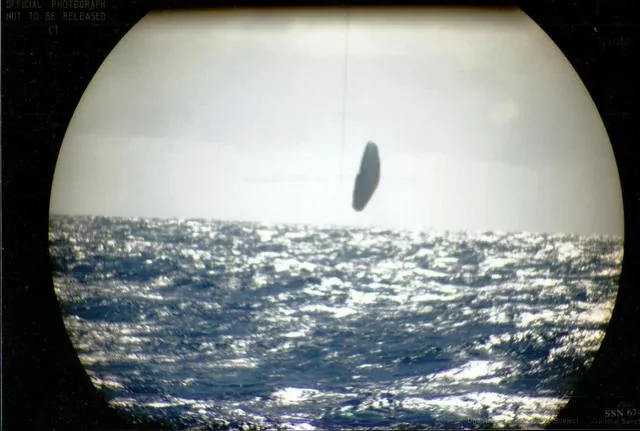
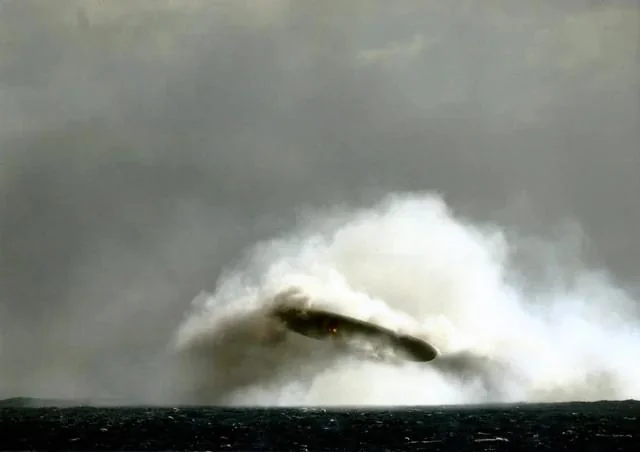
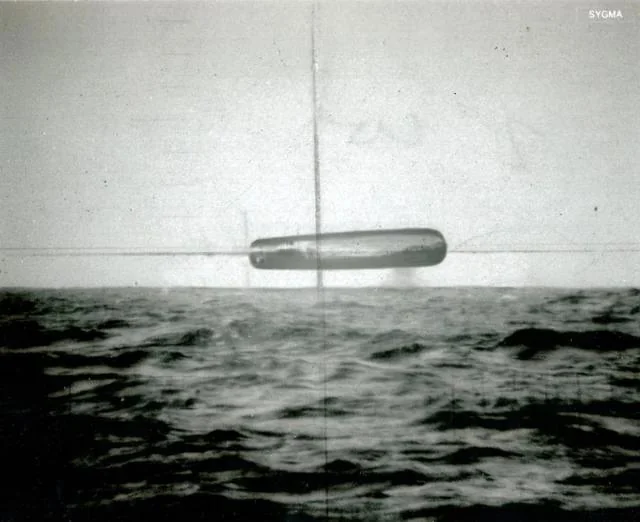
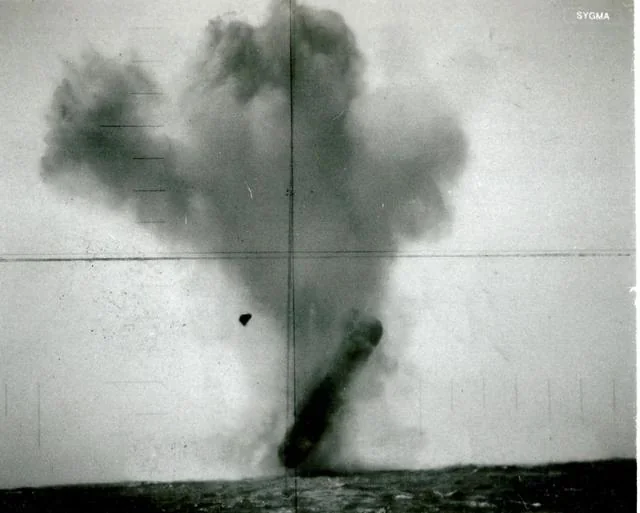
In March 1971 a set of black-and-white photographs were allegedly taken from the submarine USS Trepang while on maneuvers between Iceland and Jan Mayen Island. The images first surfaced publicly decades later, published in 2015 by the French magazine Top Secret. They show a variety of objects over sea and ice, including discs, cylinders, and geometric shapes.
The stark Arctic background gives the objects sharp definition, which is one reason the photos drew so much attention. Some of the shapes look like structured craft while others resemble balloons or aerial targets. Skeptics argue they may indeed be military test objects or photographic anomalies.
Supporters counter that the variety across the series, the clarity of the silhouettes, and the Cold War naval setting make the case unusual and difficult to dismiss. Genuine or not, the Trepang images remain some of the most dramatic photographs linked to UFO lore.
Santa Ana, California – August 3, 1965
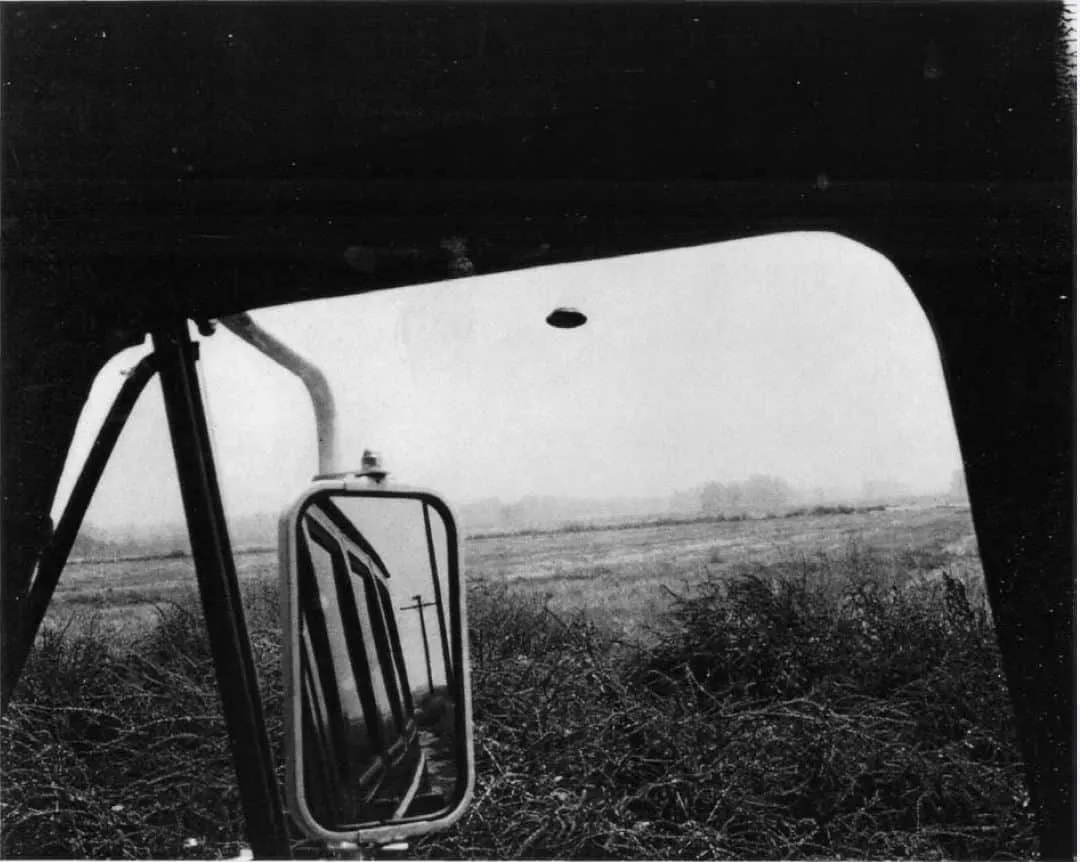
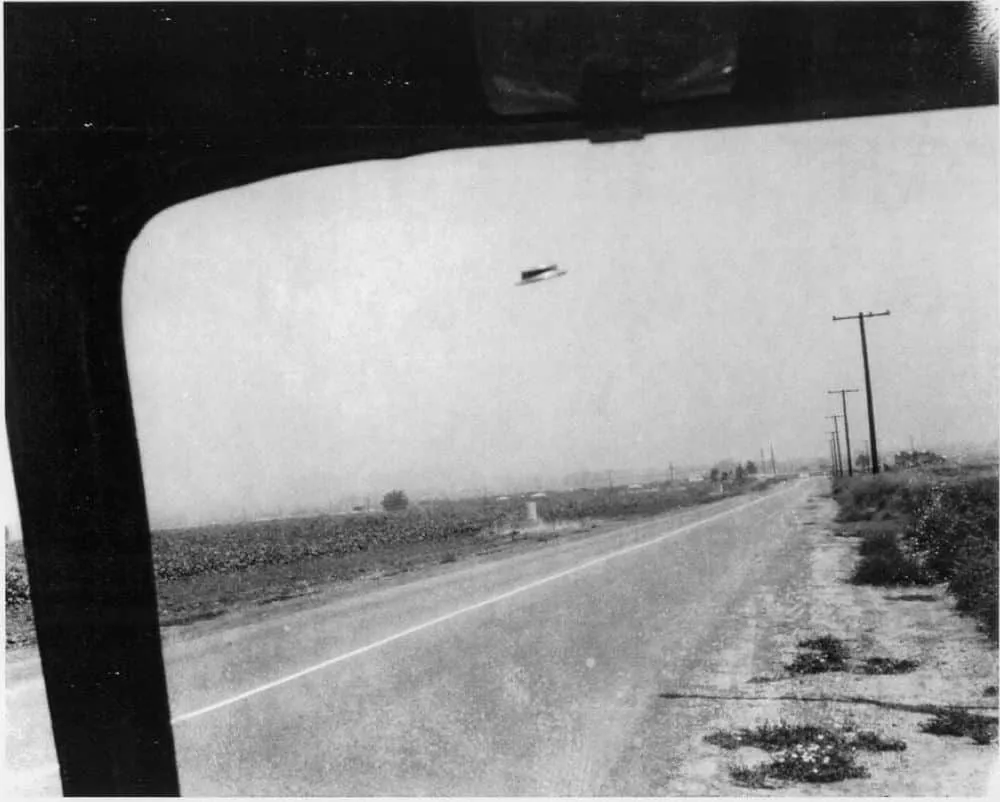
Rex Heflin, a highway inspector in Orange County, was parked near Myford Road in Santa Ana when he saw a strange disc pass across the sky. He quickly grabbed his work camera, a Polaroid, and took four shots.
The sequence shows a top-hat shaped craft hovering over the roadside. Heflin reported that the UFO moved silently across the highway before shooting away at high speed.
The photos were taken by an ordinary county employee with no apparent motive to hoax. They were even borrowed by men claiming to be from NORAD and never returned, which added to the mystery. Analyses later showed that shadows and scale were consistent with a large object in the air rather than something thrown. Skeptics have suggested it was a model or a hubcap, but no proof of trickery has been found. Decades later, the Heflin photos are still regarded as some of the clearest from the 1960s.
McMinnville, Oregon – May 11, 1950
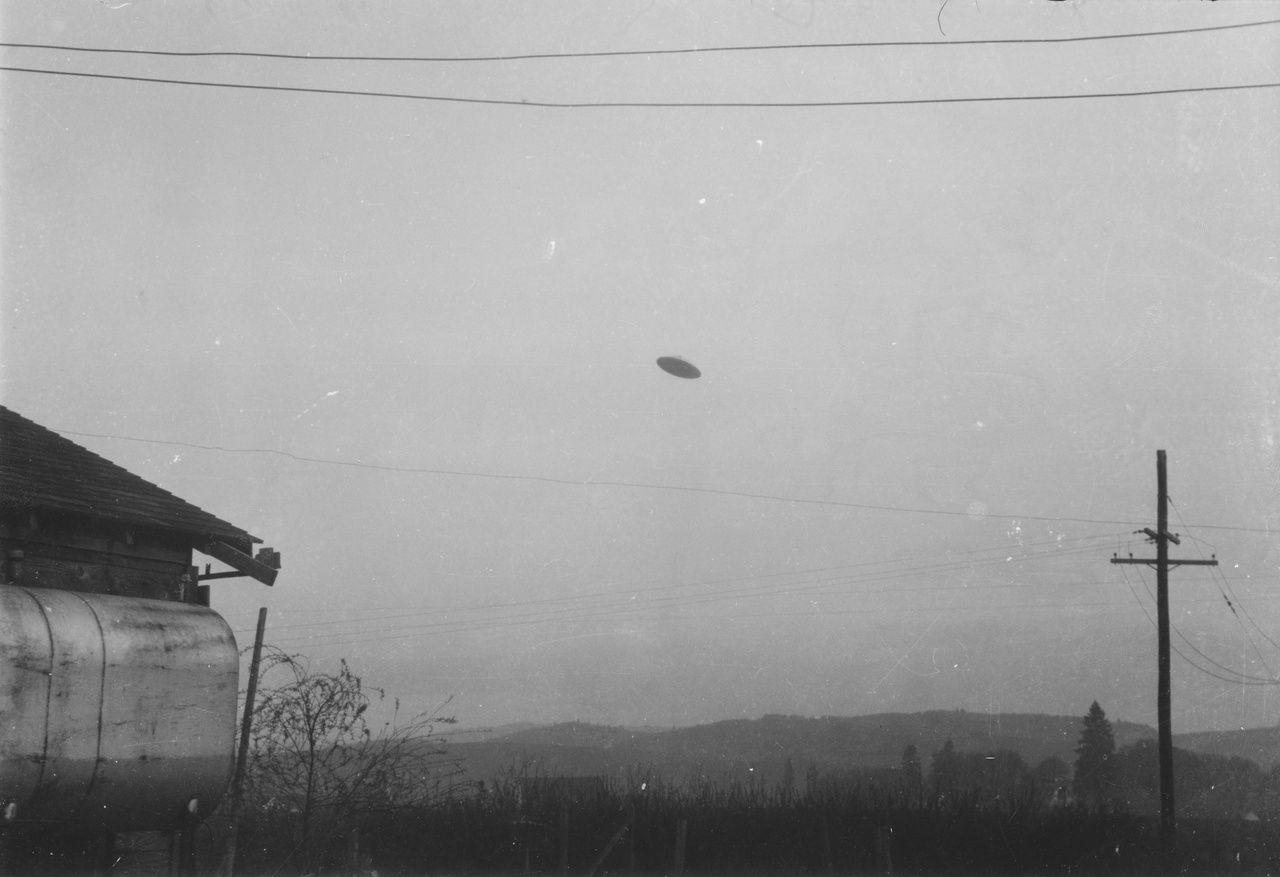
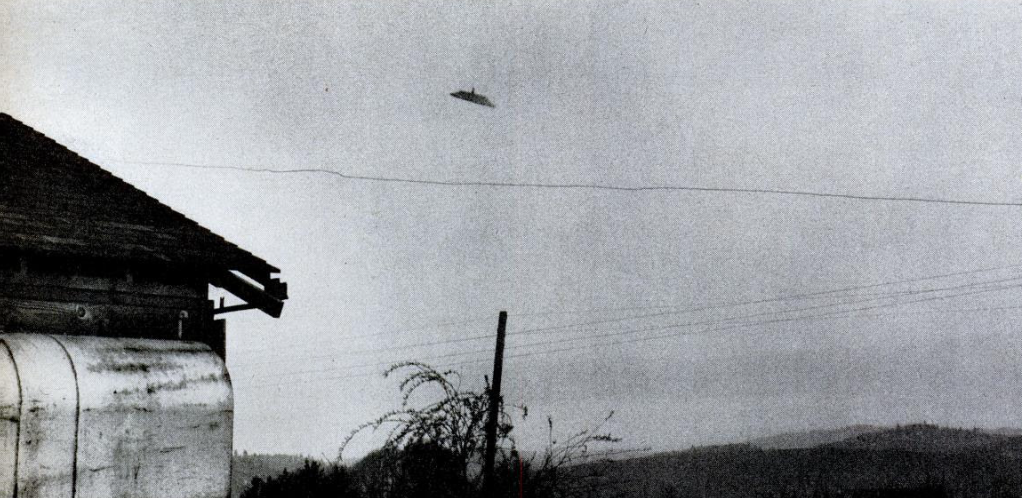
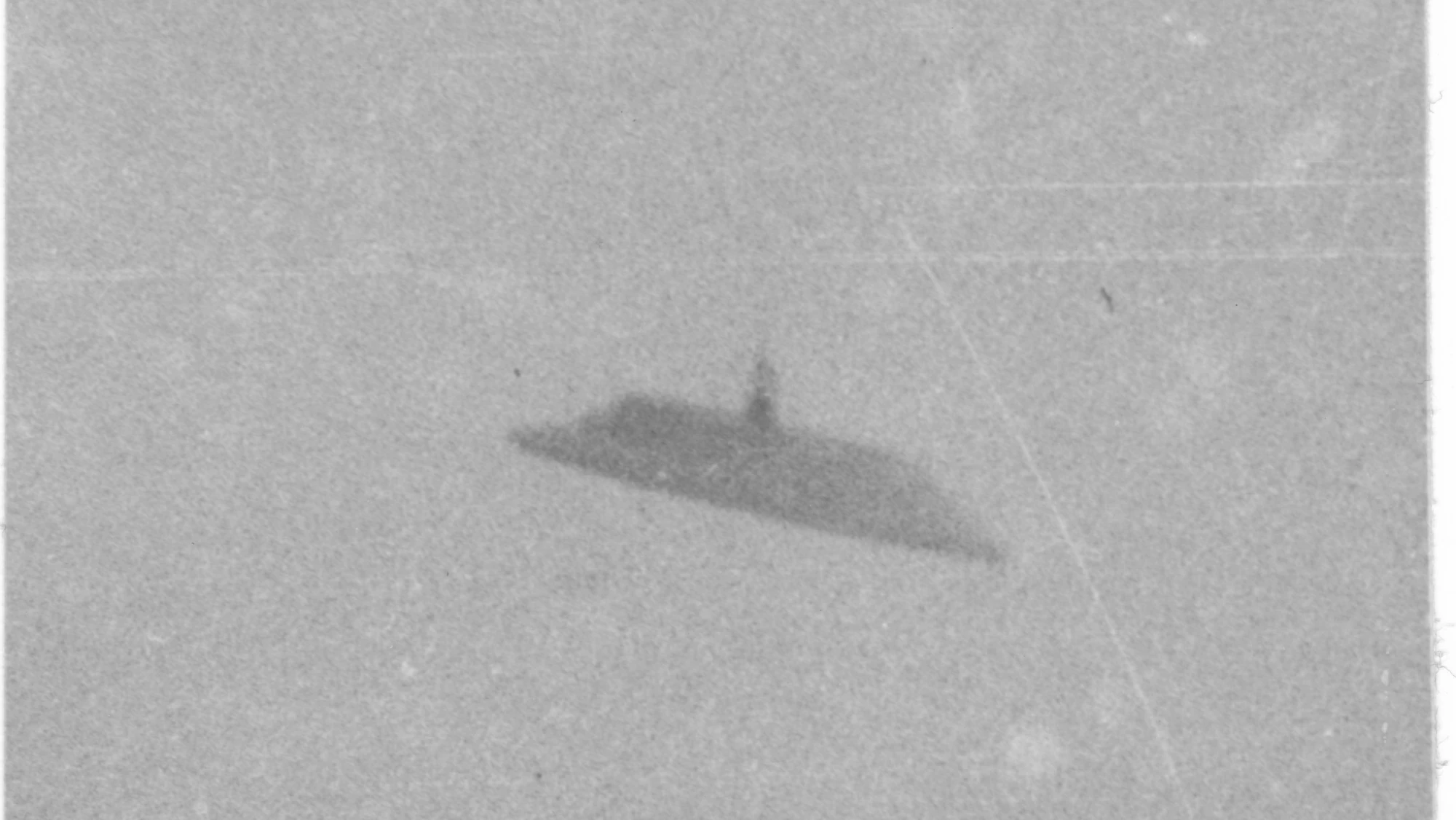
On May 11, 1950, Paul and Evelyn Trent photographed what became two of the most famous UFO images ever taken. Evelyn first noticed the object moving silently above their farm, and Paul grabbed his Kodak to capture two clear shots before it drifted off to the west. The photos show a classic disc with a domed top, tilted slightly against the evening sky.
The negatives have been studied many times over the decades, with no clear signs of tampering. Skeptics have suggested the object might have been a model hung by wire, but no proof has ever been found. The McMinnville photos remain among the most iconic pieces of UFO imagery, often called the “gold standard” for their clarity and context.
Barra da Tijuca, Brazil, – May 7, 1952
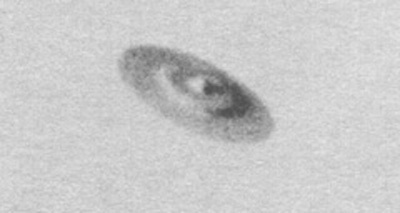
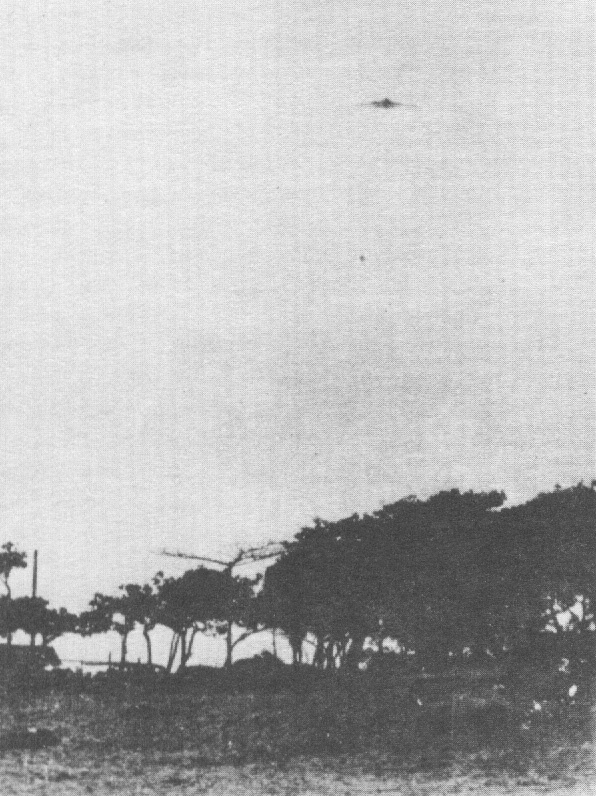
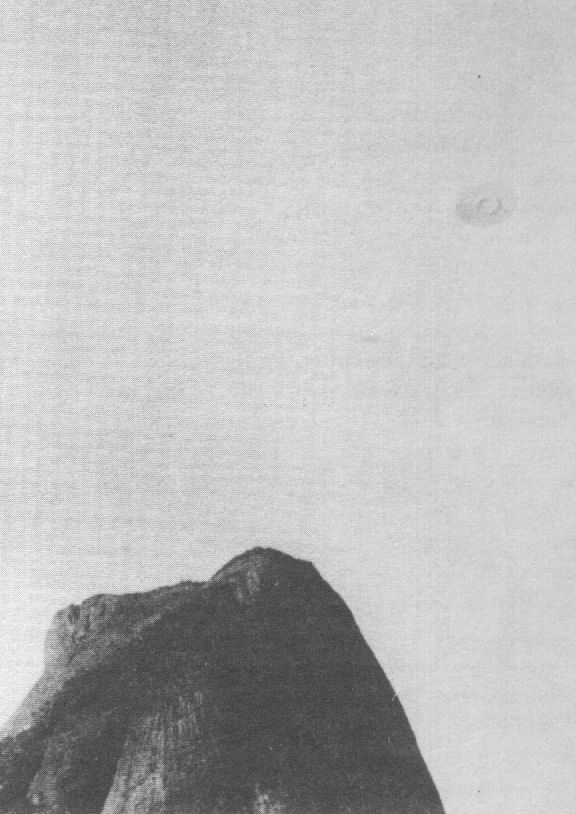
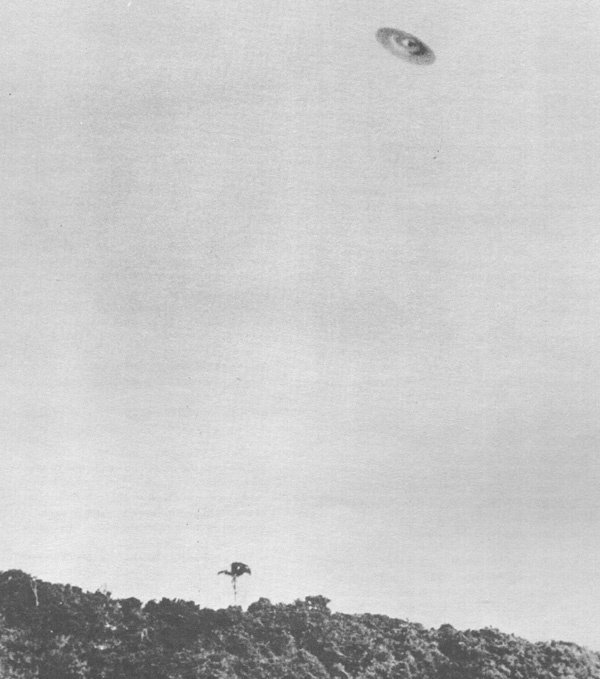
Journalist João Martins and photographer Ed Keffel were on assignment in a coastal suburb of Rio when they reported a disc approaching from the sea. Keffel snapped five photos in succession, showing a domed craft crossing the sky in broad daylight. The images were quickly published in O Cruzeiro, a major Brazilian magazine, and became a global sensation.
Critics suggested staged models or double exposures, but the multiple frames and professional setting have kept this case alive for more than seventy years. The Barra da Tijuca photos are still considered some of the clearest “daylight disc” images ever published and remain a cornerstone of Brazil’s long UFO history.
Petit-Rechain, Belgium – 1990 (Belgium UFO Wave)
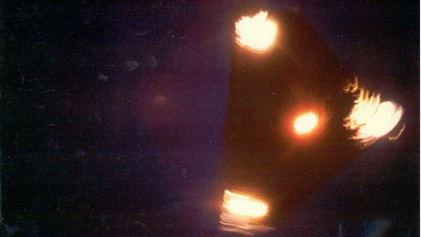
In the middle of the Belgian UFO wave, a young man from Petit-Rechain photographed a triangular craft with bright lights at its corners and a glowing center. The photo spread rapidly and became the most famous image from the Belgian sightings, which were reported by police officers, pilots, and ordinary civilians alike.
For years the picture was treated as strong evidence. Analysts said it showed no signs of manipulation and matched the many reports of low-flying triangles in Belgian skies.
Then in 2011 the photographer said it had been faked with a small model and painted lights. Some accepted the confession, others doubted it, suggesting he may have been pressured. Regardless of the truth, the photo remains one of the most recognizable images of the UFO wave and continues to be used as shorthand for the mysterious black triangles.
Redbud, Illinois – 1967
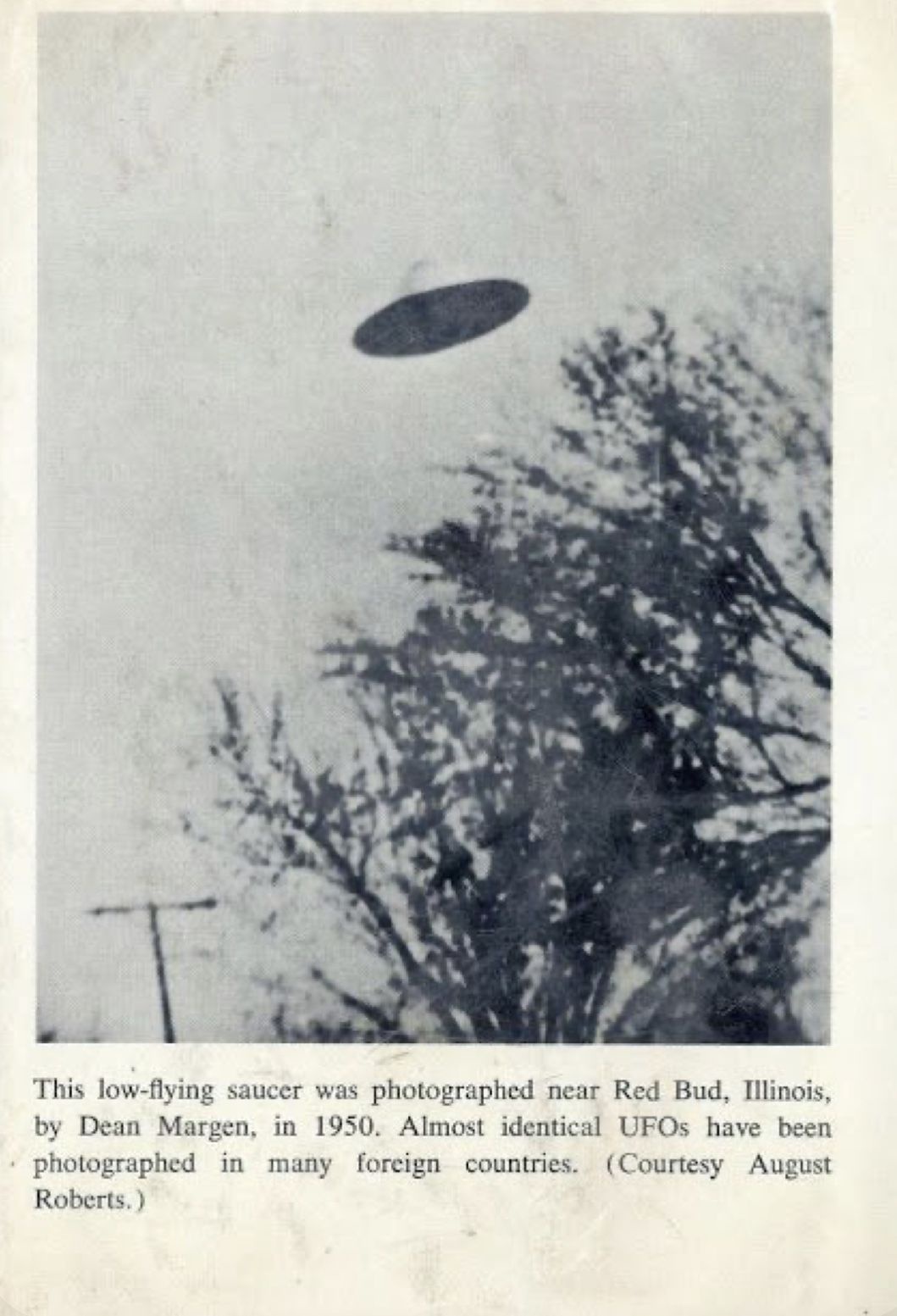
In March 1967 farmer William Barnes used his Polaroid camera to capture several images of a large oval object near his property. The photos show a disc with a domed top, solid in form, and consistent shadows that suggest it was a real object in daylight.
Barnes’ photos caught the attention of J. Allen Hynek, the astronomer who later became one of the leading UFO researchers. Hynek thought the case was worth deeper study and noted that the photos did not look like hoaxes.
Skeptics said the object could have been something tossed in front of the camera, but the multiple frames and the difficulty of altering Polaroids made the case stronger. Today the Redbud sequence remains a lesser known but important entry in UFO photo history.
Monte Grande Photo, Puerto Rico – 1988
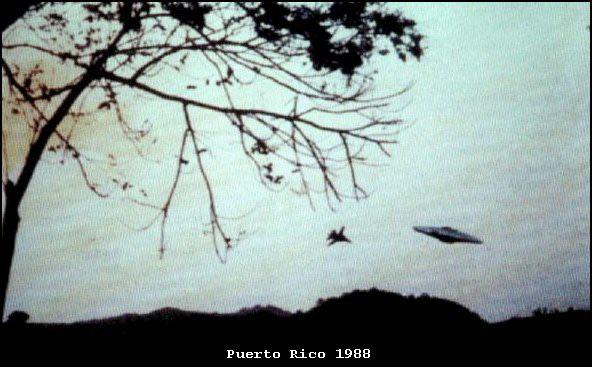
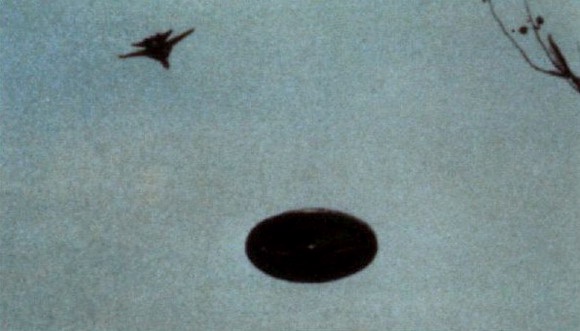
In 1988 residents near Cabo Rojo in Puerto Rico reported a strange object hovering over the treetops with what appears to be a military jet following it. One local captured a photograph that shows a disc with a domed top with flat underside tilted against the sky.
The clarity of the image and the way the object seems close to the trees makes it unusual compared to distant light photos. Witnesses claimed it hovered silently, pulsing with light, before vanishing. The case gained further attention because Cabo Rojo was a hotspot for UFO sightings at the time, with numerous locals reporting similar discs and triangles.
Skeptics argue it could have been an aircraft, a model, or a photographic trick. Supporters see it as one of the clearest shots from Puerto Rico’s active wave of sightings in the late 1980s.
San José de Valderas, Spain – June 1, 1967
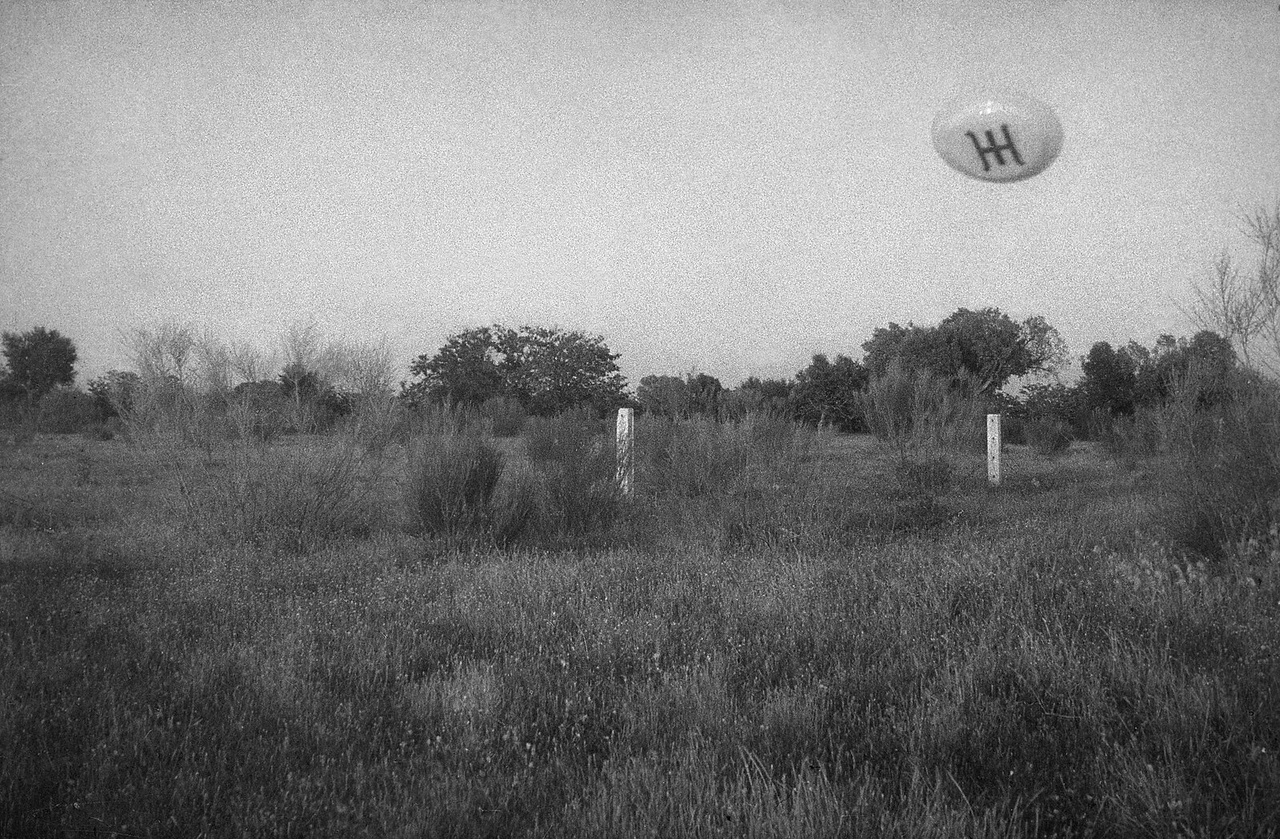
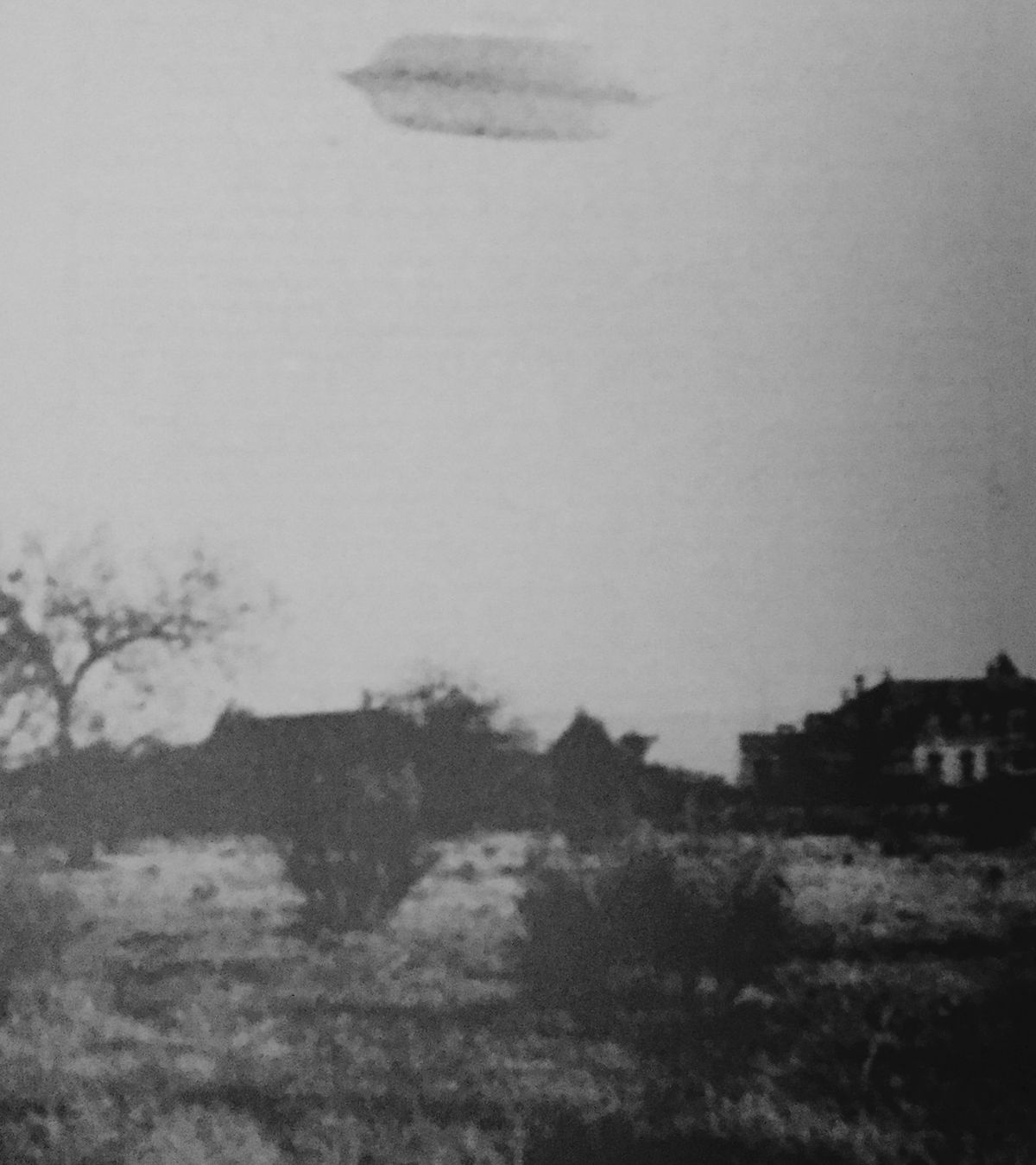
In a Madrid suburb several residents photographed a disc-shaped object in the evening sky. The object appeared metallic and tilted as if maneuvering. The case quickly became tangled with the Ummo affair, a series of letters claiming to come from extraterrestrials. Some said that it’s the Ummo symbol visible on the underside of the disc.
The photographs were published in newspapers and UFO journals, sparking debate. Supporters considered them among the best daylight evidence of the time, while skeptics pointed to the suspicious tie-in with the Ummo mythology and suggested models were tossed in the air to stage the shots.
Even with those doubts, the Valderas photos are still considered iconic. They represent both a strange sighting and the way UFO lore and mythmaking became intertwined in 1960s Europe.
California, USA, The Amalgamated Flying Saucer Club of America – June 16, 1963
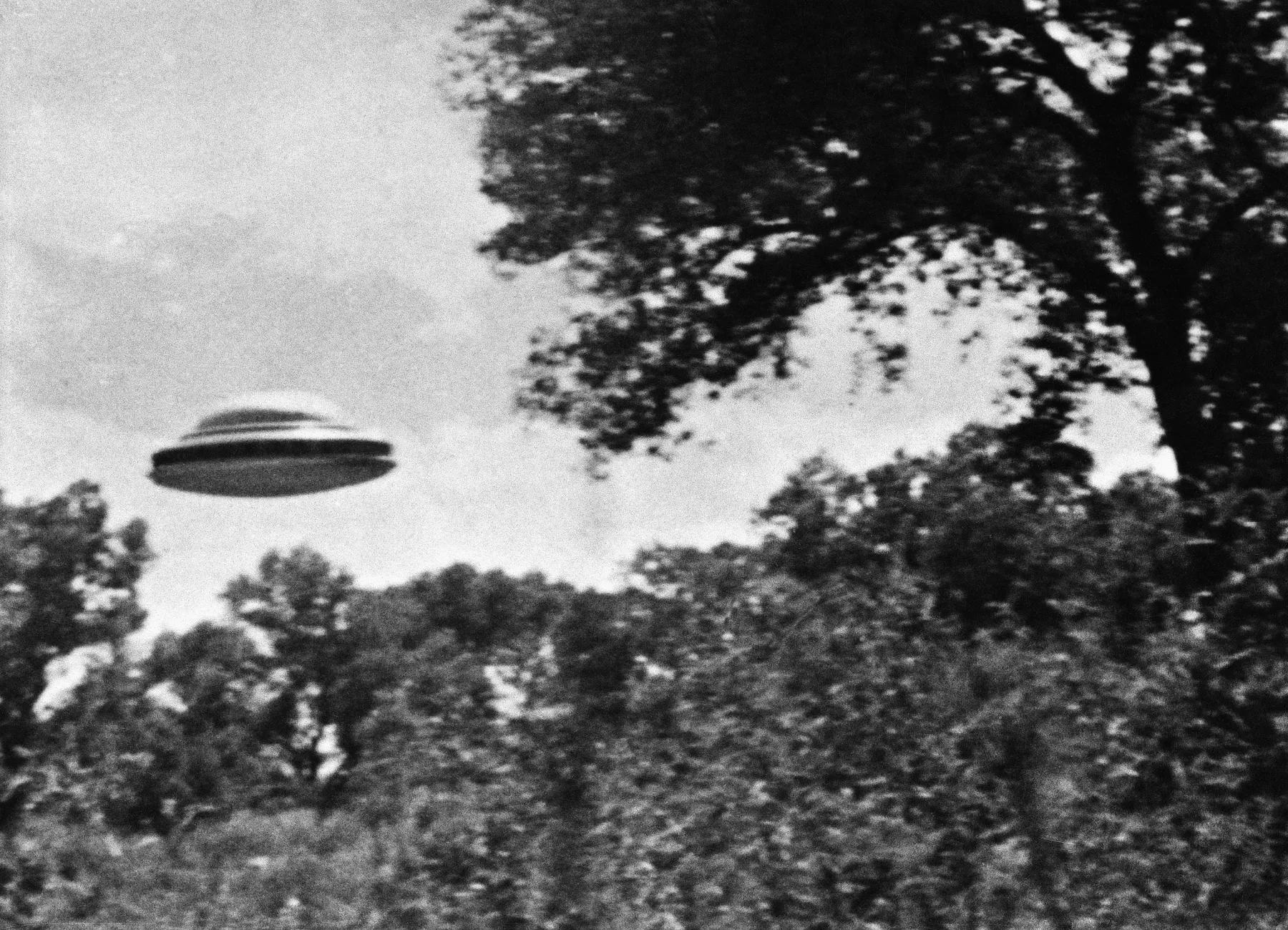
Members of a Los Angeles UFO club released a photo they said was among the clearest saucer images ever taken. The daylight picture shows a classic domed disc. It was promoted heavily in newsletters and club circles at the time.
Critics argued that it looked like two metal bowls stuck together and thrown into the air. The lack of negatives or independent witnesses makes the case weak. Yet the image remains an artifact of UFO culture in the contactee era, reflecting both the hunger for proof and the eagerness to present dramatic evidence.
Riverside, California – November 23, 1951
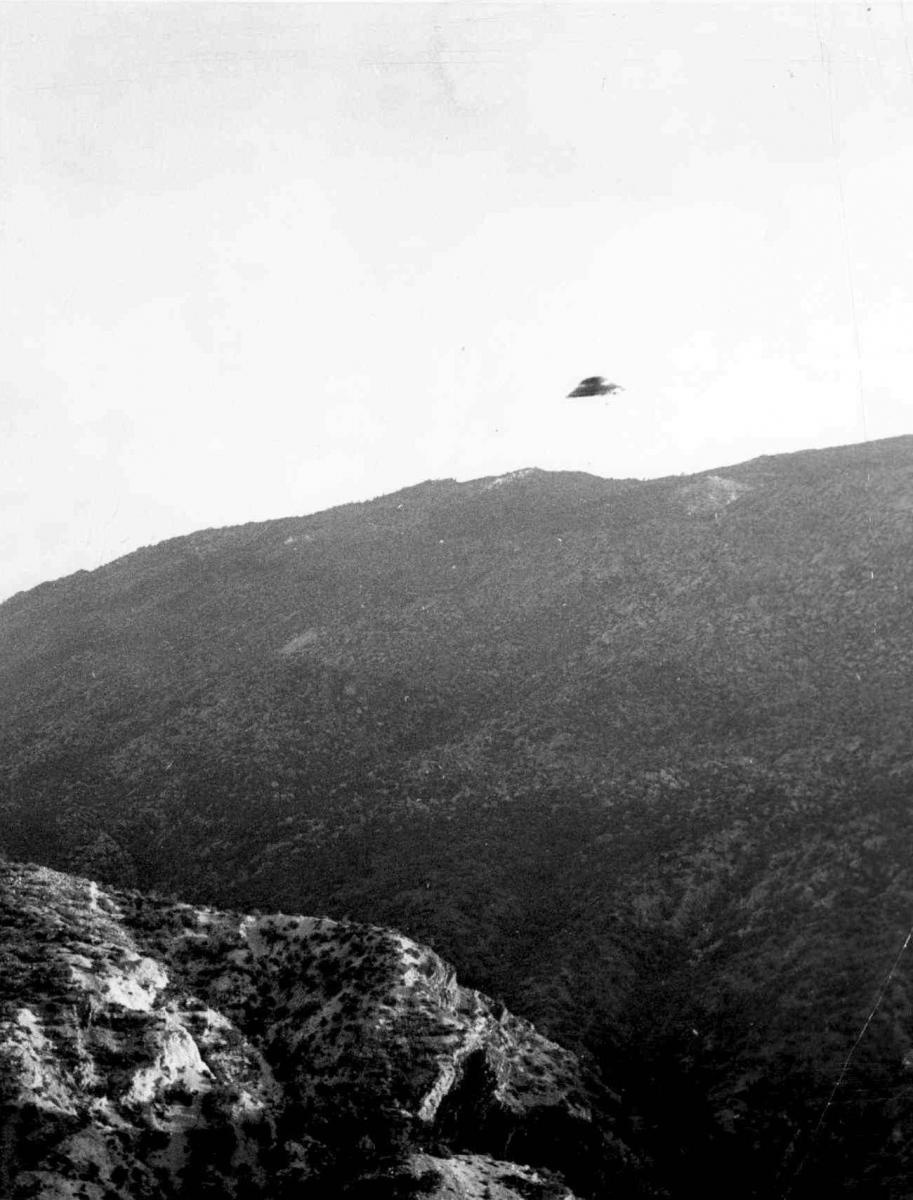
A black and white photo taken over the mountains near Riverside shows a disc with a domed top hanging over a ridgeline. The solid shape and the lack of wings or tail give it a striking presence.
The timing is notable. It came just months after the Lubbock Lights and during a period of heightened UFO activity across the United States. The photo’s proximity to March Air Force Base made it especially interesting to researchers. While debates over authenticity continue, it remains one of the most famous early saucer shots.
Salem, Massachusetts – 1952

On July 16, 1952 Coast Guardsman Shell R. Alpert photographed four bright lights in a triangle pattern above the U.S. Coast Guard station in Salem. Parked cars and an industrial building anchor the scene, giving it scale.
The lights appear featureless, like glowing orbs, with no wings or tails. Skeptics say they may have been reflections on glass, but the fact that the photo was taken in the midst of the intense 1952 UFO wave keeps it significant. It has remained one of the most talked about images from that summer.
Antioquia, Colombia – 2022
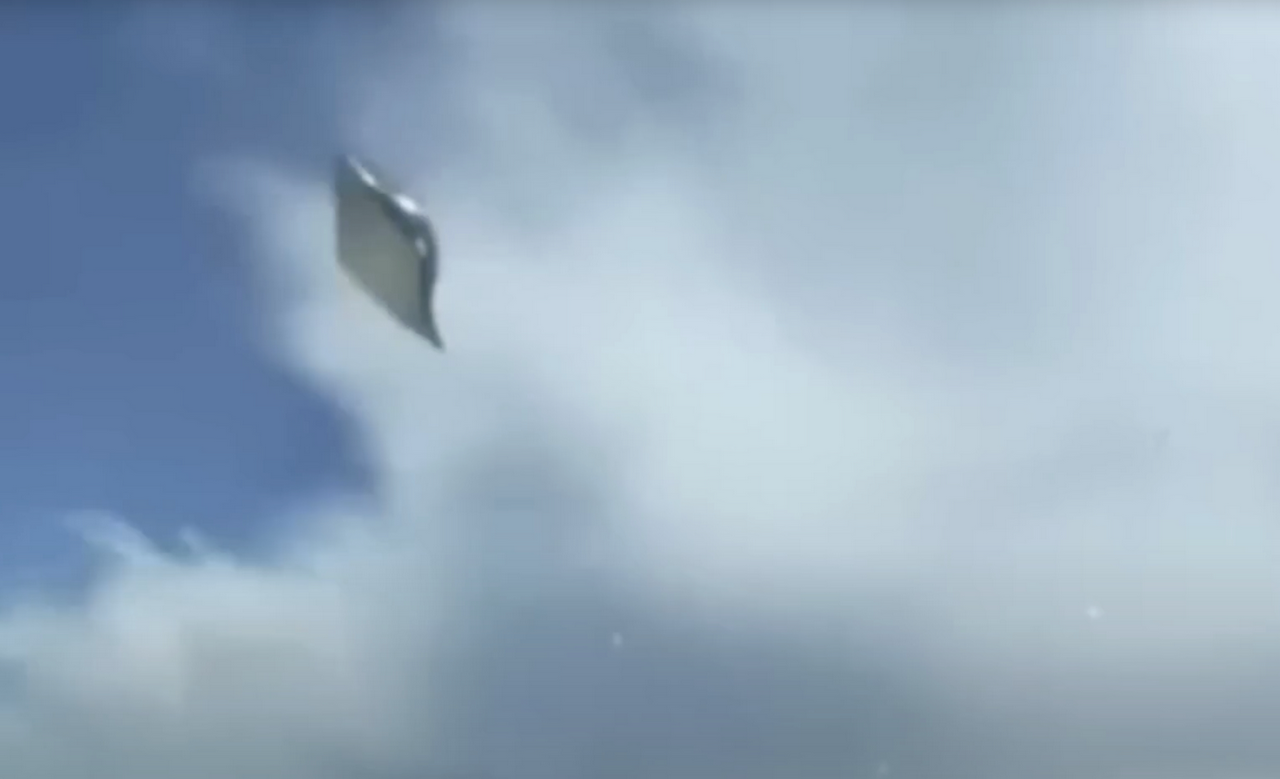
In May 2022 pilot Jorge A. Arteaga filmed a strange object from the cockpit of his aircraft at about 12,500 feet. The video shows a manta-ray shaped craft hovering in the clouds before moving quickly past the plane.
Arteaga ruled out balloons, noting the altitude, the temperature, and the speed of the object. The footage spread quickly online and was hailed by some as among the clearest recent UFO videos. Its structure and motion do not match drones or conventional aircraft.
The Antioquia film remains one of the most discussed modern cases, a rare clear cockpit capture that continues to raise questions.
The Flyby UFO Video (mid-2000s)
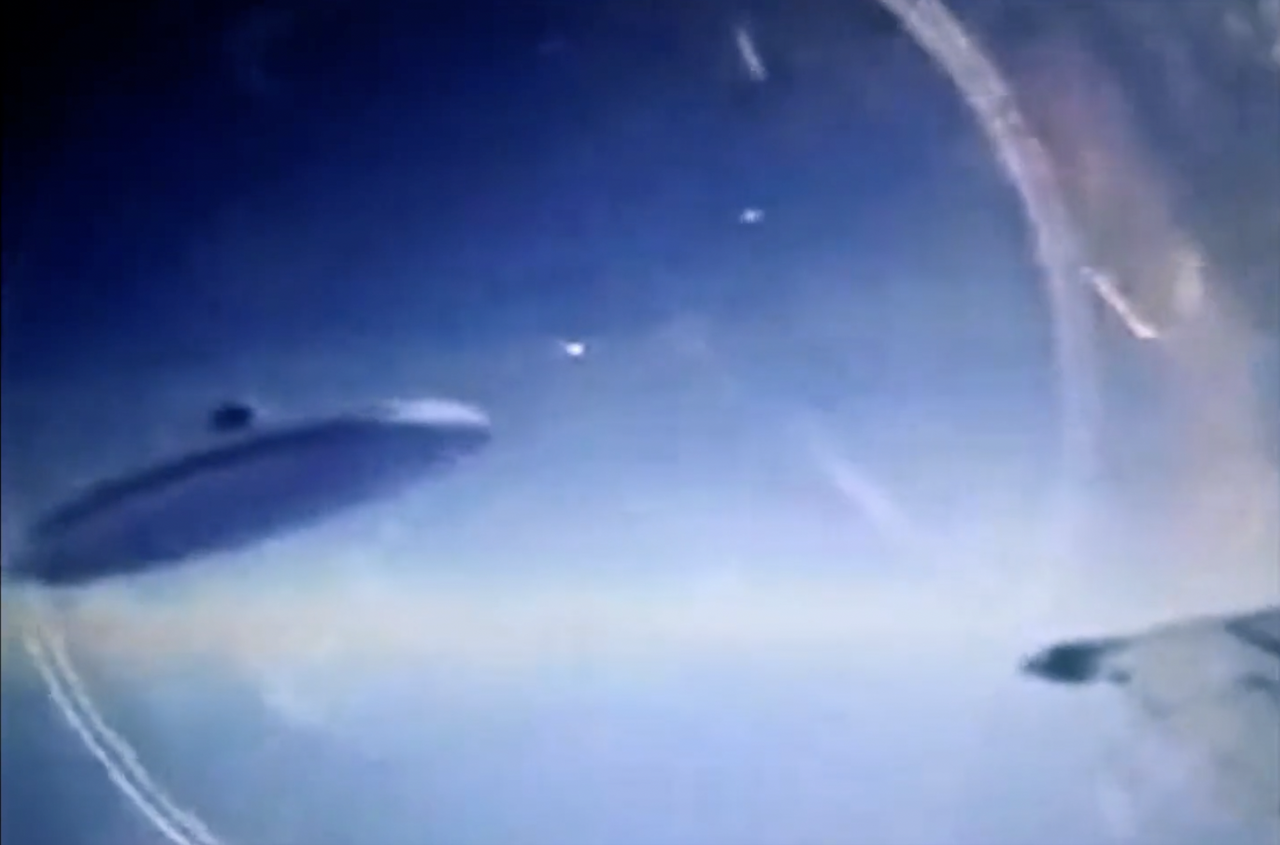
A short clip often called the Flyby UFO shows a metallic disc with a domed top moving past what appears to be a jet at altitude. The craft streaks by at close range, giving the impression of a near-miss.
What makes the clip unusual is the suspicion that it may not be a direct cockpit recording, but rather a video of a screen showing military footage. That possibility only fuels speculation about its origin.
Whether leaked military material or an elaborate hoax, the Flyby UFO clip remains one of the most recognizable pieces of UFO media online.
PS: I’ve done a deep dive on this one, check out my post about it here!
Treviso, Italy – June, 1979
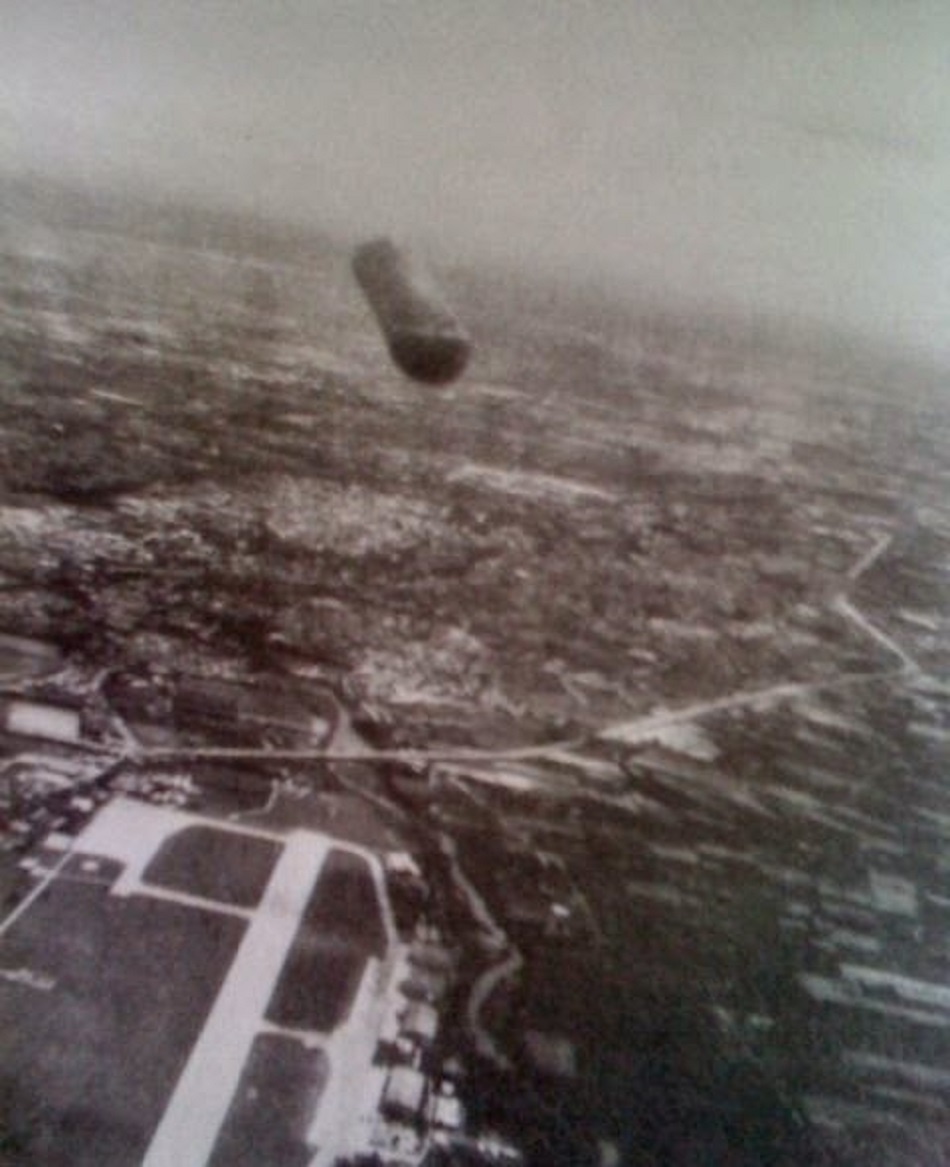
Italian Air Force pilot Giancarlo Cecconi photographed a large, capsule-shaped object near Treviso Air Base while flying a reconnaissance jet. The smooth tic-tac form showed no wings, tail, or propulsion.
Cecconi said the object maneuvered in ways balloons could not, and radar reportedly confirmed a contact at the time. Skeptics suggest a weather balloon or photographic anomaly, but no firm explanation has ever been agreed on.
Because it was taken by a trained pilot in daylight conditions, the photo is considered one of Europe’s clearer UFO cases.
Phoenix, Arizona – March 13, 1997 (Phoenix Lights)
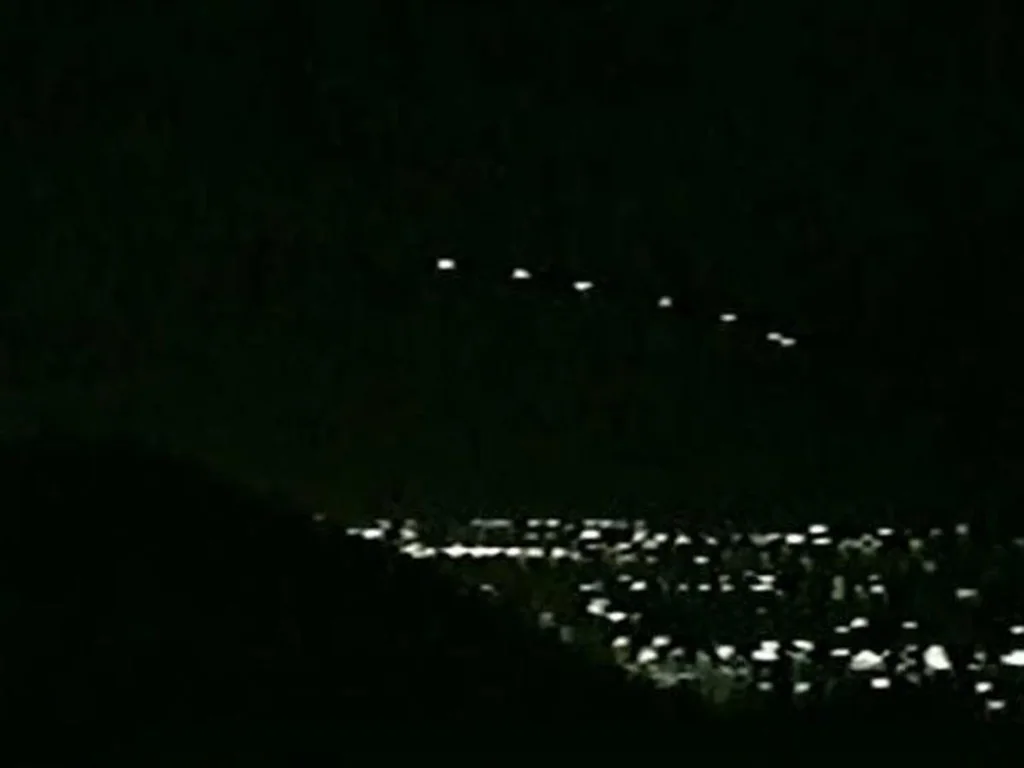
On the night of March 13, 1997 thousands of Arizona residents saw enormous V-shaped formations of lights crossing the sky. Photographs and videos taken in Phoenix show glowing orbs lined up in formation, silent and steady as they drifted overhead.
The U.S. military later claimed the lights were flares from a training exercise, but many witnesses insisted they saw a massive craft blocking out stars. The Phoenix Lights remain one of the most widely reported UFO events in modern history.
Disclaimer: I was unable to verify the source of the above image. Based on research it’s possible this is a photo of the military flares dropped later, in order to discredit the original mass sighting.
Lubbock, Texas, USA – Aug 31, 1951 “The Lubbock Lights”
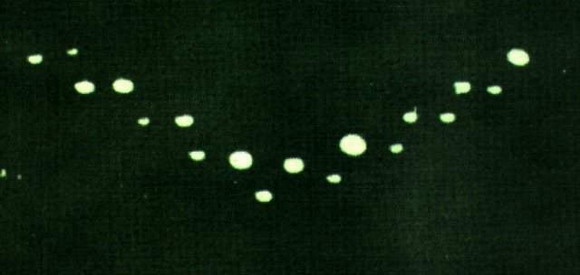
Decades before the Phoenix Lights, another famous V-shaped formation lit up the skies over Texas, nicknamed “The Lubbock Lights.”
The first sighting came on August 25, 1951, when four Texas Tech professors, out stargazing, watched a cluster of glowing blue-green lights sweep silently overhead in a loose arc. Over the following three weeks, more than a hundred witnesses across Lubbock reported seeing the same mysterious formations.
On August 31, a college freshman managed to photograph the lights during one of several passes over the city. The images show a V-formation of luminous objects — nearly identical in shape to what thousands would later report over Phoenix in 1997. Witnesses described anywhere from 15 to 30 lights in each flight, sometimes appearing to pulsate or “wiggle” as they moved, with no sound and no gradual fading in or out as an aircraft would.
Air Force investigators studied the case, noting the lights traveled with incredible speed and maintained a consistent formation. The photographs were analyzed and found to show independent points of light rather than a single craft, though no conclusive explanation was ever given. To this day, the Lubbock Lights remain one of the most famous mass UFO sightings in American history.
Vancouver, British Columbia – 1937
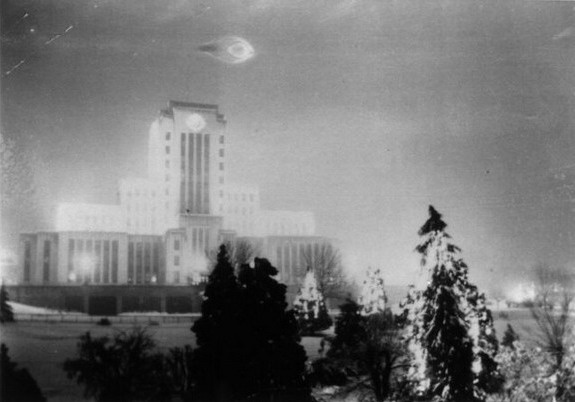
In December 1937 Leonard and Wilfred Lamoureux were photographing Christmas lights at Vancouver City Hall when they saw a bright blue object descend from the sky. Leonard described it as two saucer halves glowing blue, which stopped above the flagpole before shooting straight up.
The photo shows the glowing shape above the building. Leonard’s daughter later confirmed that the negative was clean and that the camera was on a tripod, not a long exposure.
The original negative has been lost, but the photo remains one of Canada’s earliest UFO records and a vivid example of how the phenomenon was reported long before modern media.
Los Angeles, USA – February 25, 1942 (Battle of Los Angeles)
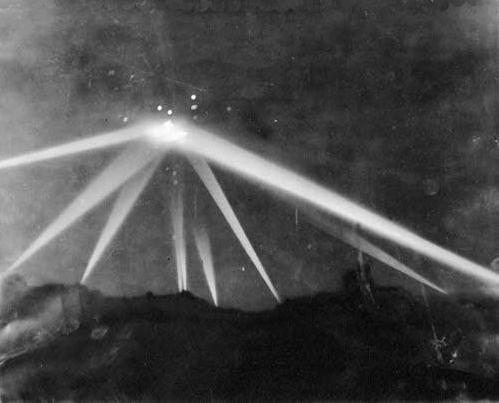
In the early hours of February 25, 1942 anti-aircraft guns opened fire over Los Angeles after searchlights locked onto a slow moving object. For hours the city was in blackout while shells lit up the sky.
The military later blamed false alarms and weather balloons, but photographs from the night show a glowing shape caught in the beams. Thousands of residents saw it, and the incident has been argued about ever since.
The Battle of Los Angeles remains one of the most dramatic UFO episodes ever to play out over a major city.
France – 1974
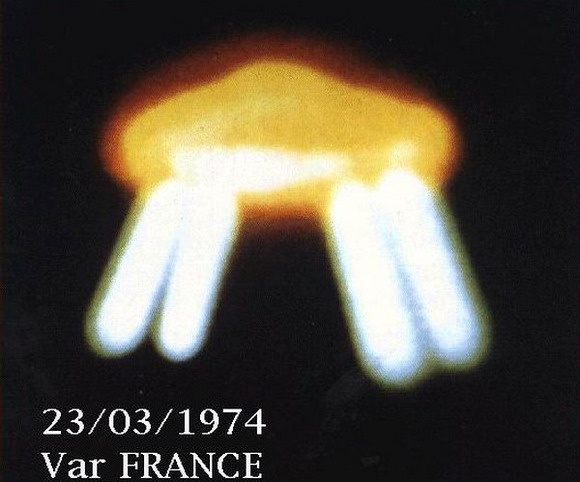
In 1974, a striking UFO photograph was taken in France that continues to circulate as one of Europe’s more puzzling cases. The image shows a luminous, oval-shaped craft with a clear central glow, with white streaks emitting from it against the night sky. Witnesses described it as a solid object that emitted a steady light rather than a fleeting flash or reflection.
Skeptics have suggested possibilities such as lens flare, aircraft lights, or photographic tricks, but the photo’s clarity and the lack of obvious tampering gave it staying power. Unlike many daylight “disc” shots, this one carries an eerie atmosphere, with the bright craft dominating the frame and leaving few visual cues to dismiss it outright.
Though not as famous as Calvine or McMinnville, the 1974 France UFO photo remains an enduring piece of European UFO lore, debated for decades and still unsolved.
Chiba, Japan – 1975
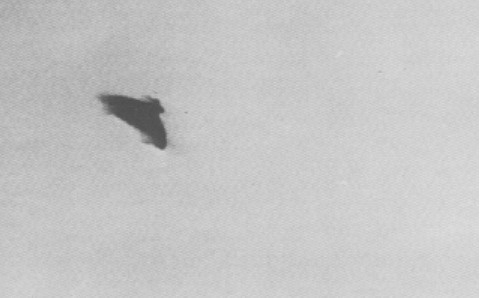
In 1975, a series of photographs taken in Chiba, Japan, captured what appears to be a luminous, structured craft hovering in the sky. The object shows a domed, almost metallic shape with a glowing underside, giving it the classic “flying saucer” look. The photos were sharp enough that they quickly circulated in Japanese newspapers and UFO publications worldwide.
Witnesses reported that the object remained stationary for several moments before silently moving off, leaving no trail or sound. Investigators at the time noted that the images didn’t match known aircraft of the era, and no official explanation was ever issued. Some skeptics dismissed the photos as a hoax using a small model, but no clear evidence of fakery was ever proven.
Today, the Chiba photographs are regarded as some of the most iconic Japanese UFO images of the 1970s — visually striking and still mysterious half a century later.
Japan – 1970
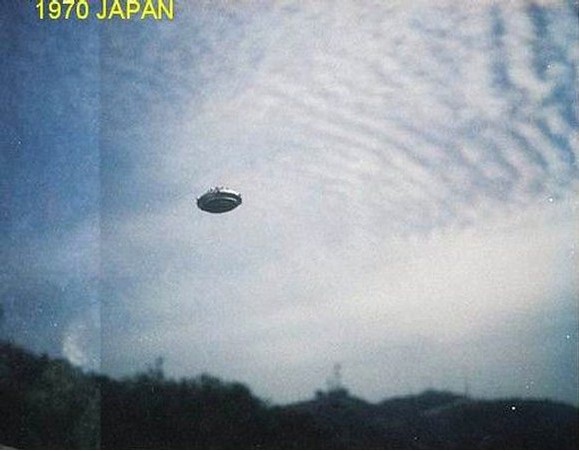
A widely circulated photo labeled “Japan 1970” shows a metallic saucer hovering above the hills. The object appears to have a structured underside, standing out clearly against the sky.
Little is known about the photographer or the original source, which makes the case hard to verify. Even so, the image has remained in UFO literature for decades as a textbook example of the saucer era.
Tepoztlán, Mexico UFO – 1985
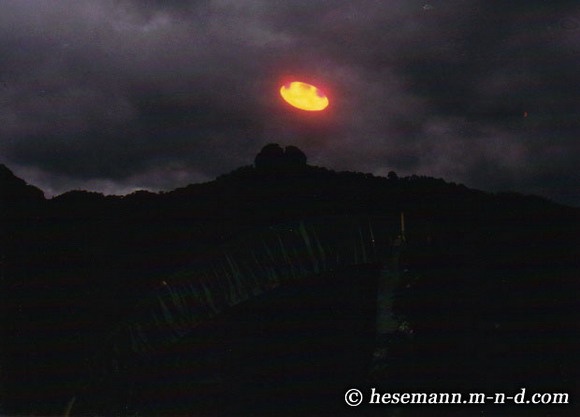
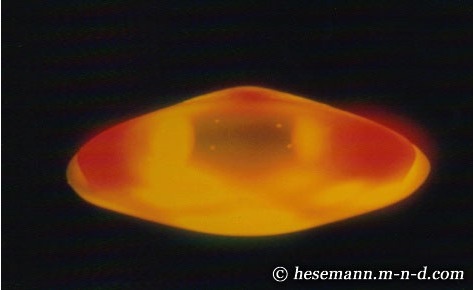
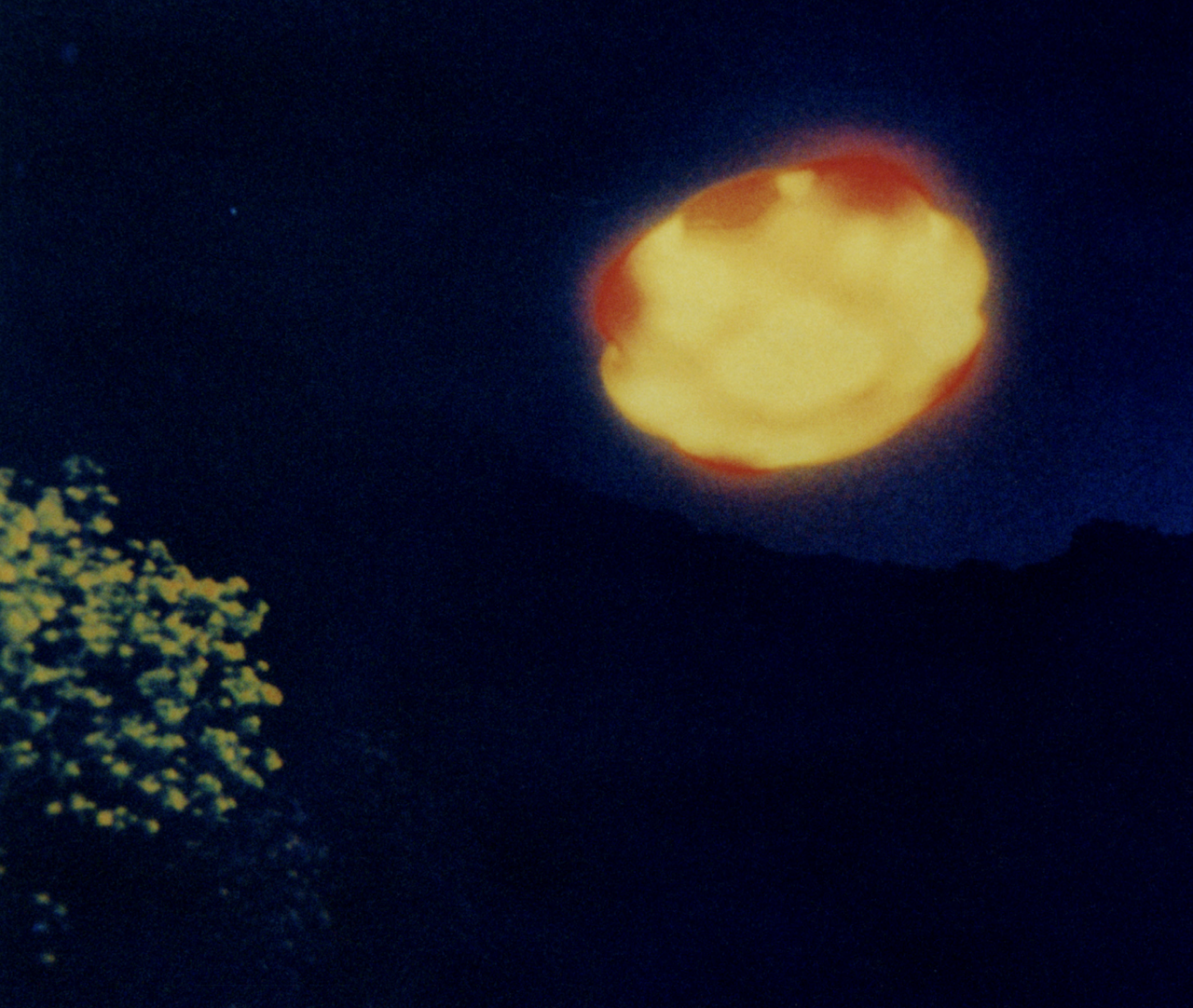
In the mid-1980s, a photograph from the town of Tepoztlán, just south of Mexico City, became one of the most famous UFO images to come out of Mexico. The picture shows a craft glowing with an orange and yellow light, almost like molten metal, set against the night sky. Unlike the usual metallic saucer photos, this one looks as if it was lit from the inside, giving it an unusual, almost organic look that made it stand out.
The photo has often been connected to Carlos Díaz, who went on to take more pictures of similar objects in the same area throughout the 1980s and 1990s. People who claimed to see it described the craft as completely silent, hovering and pulsing with light before suddenly disappearing. Believers point to the clear structure and detail in the image, while skeptics argue it may have been a model, a trick with lighting, or some staged setup. Whatever the case, the Tepoztlán photograph has held its place in Latin American UFO history as one of the most striking and hotly debated sightings.
PS: I’ve done a deep dive on this one, check out my post about it here!
Ocotlán, Jalisco, Mexico – 1993
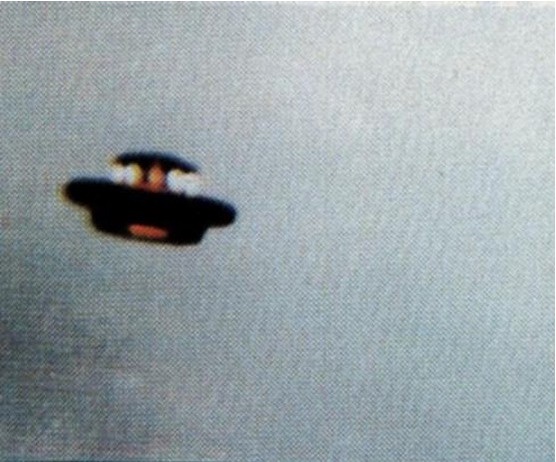
In September 1993, people in the town of Ocotlán, Jalisco reported seeing a huge disc-shaped object moving silently overhead. Witnesses said it looked metallic and carried bright circular lights around its top edge, hovering across the sky before suddenly shooting away at high speed. Some even recalled that the craft seemed so large it blocked out whole sections of the sky as it passed.
The sighting caused a stir throughout Mexico, and photos began to circulate showing a glowing craft with a clear outline. Skeptics argued it was nothing more than a plane or a photographic trick, but locals who saw it in person insisted it was unlike anything familiar. The story made headlines in the Mexican press and quickly became one of the best-known UFO cases of the 1990s, remembered for the size of the object, the number of witnesses, and the national attention it sparked.
Wisconsin, USA – 2003
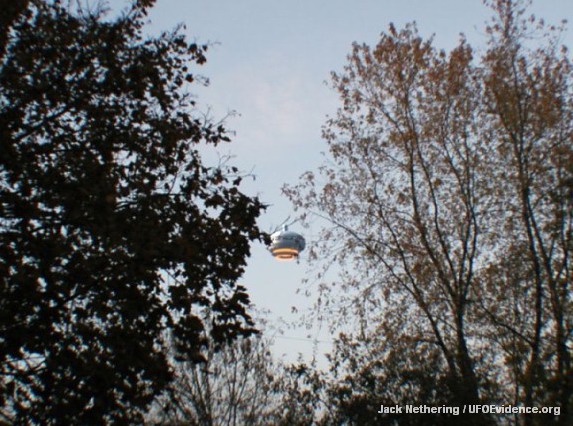
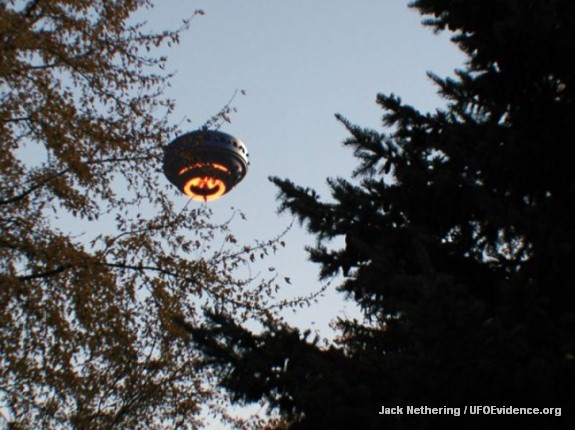
In 2003, Paul Scheeler of Wisconsin snapped a photo that quickly made the rounds in UFO circles. Shot in broad daylight, the picture shows a metallic object with an orange glowing underside, caught between the trees. Some have compared it to the look of a chandelier hanging in the sky.
Scheeler said the object hovered silently for a moment before vanishing without a sound or trace. The photo spread online through forums and sites like UFOEvidence.org, drawing attention because of its sharp detail and unusual orange glow. Skeptics have suggested it might be a model or a digital trick, but no proof of fakery has ever surfaced. Today, it’s still seen as one of the standout UFO photos of the early internet era.
Provo, Utah – 1966
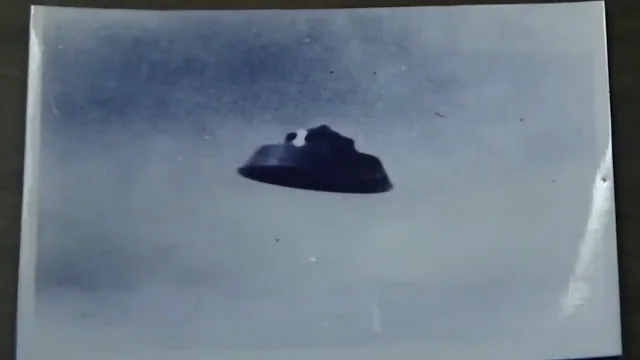
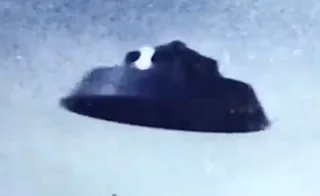
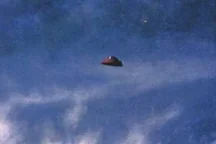
In July 1966, a U.S. Air Force pilot flying a C-47 transport over the Rocky Mountains near Provo, Utah, snapped two unusual color slides of something in the sky. The photos show what looks like a classic saucer with a domed top, surrounded by small circular shapes jutting out from its sides. In the second frame the object appears to have shifted slightly, hinting at movement in the few seconds it was visible.
The case has been debated ever since. The Condon Committee later dismissed the photos, suggesting they were probably just a small object tossed into the air, pointing to inconsistencies in the film sequence as evidence. Even so, the images have lived on as some of the more memorable UFO shots of the 1960s. What keeps the debate alive is how much the craft resembles Mark McCandlish’s later technical drawings of the so-called Alien Reproduction Vehicle, with the same domed top, circular hull, and dark “porthole” band. That resemblance has led some to wonder if the Provo photos captured an early glimpse of the very technology McCandlish would later describe.
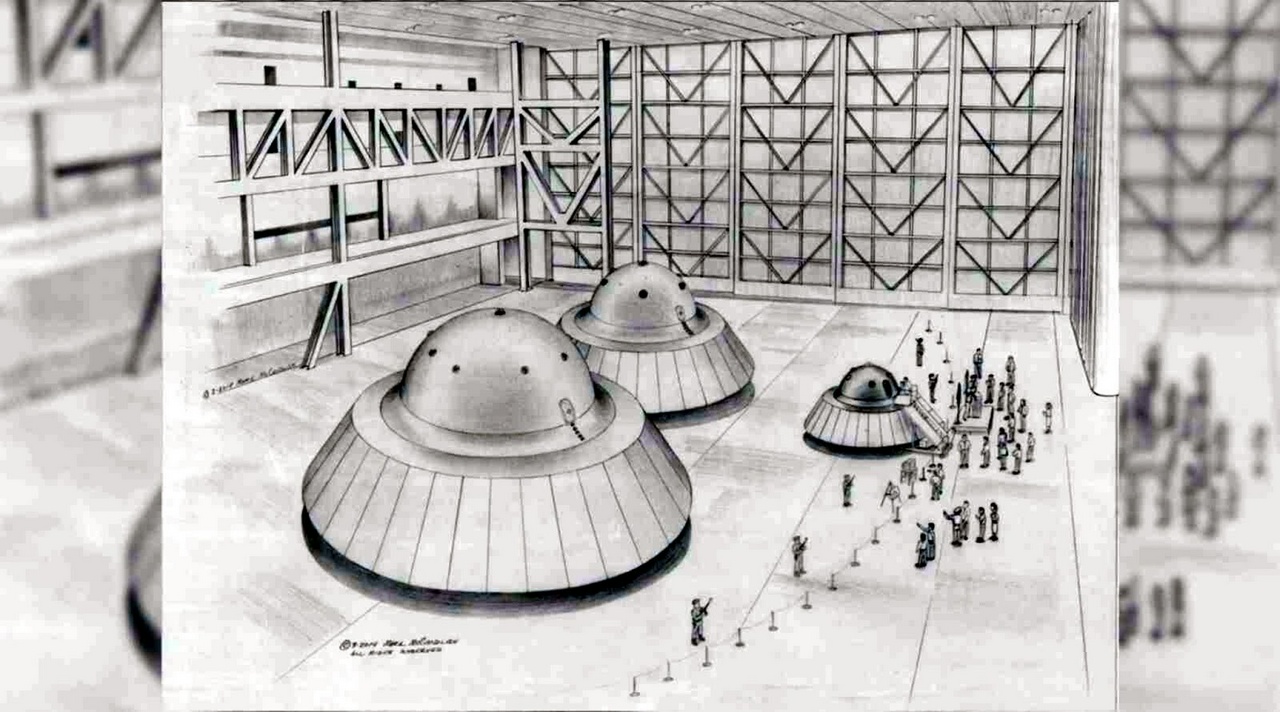
Winona, Missouri – 1957
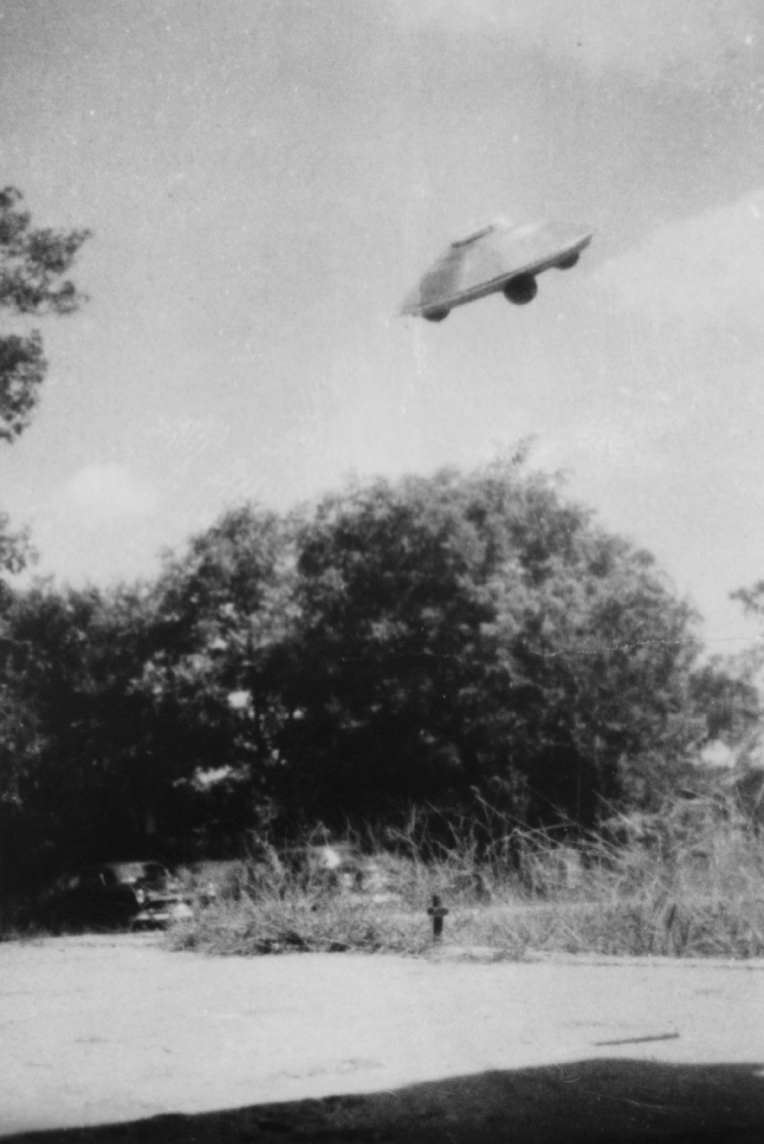
In 1957, Tom O’Bannon of Winona, Missouri snapped one of the stranger UFO photos of the decade. The picture shows a disc-like craft above the treeline with three dark spheres beneath it. Unlike the typical “flying saucer” shots of the era, the underside of this object looks unusual and gives it a distinctive appearance.
The photo made its way into UFO books and magazines, quickly becoming part of the mid-century wave of sightings. Skeptics later suggested it might simply show a chicken brooder, a common piece of farm equipment, tossed or staged to look like a saucer. Even so, the odd design—especially the ball-shaped features underneath—doesn’t match most known hoaxes from the time. Whether it was a trick, a misidentified object, or something unexplained, the Winona photo has held on as a curious piece of 1950s UFO history.
Tientsien (Tianjin), China – 1942
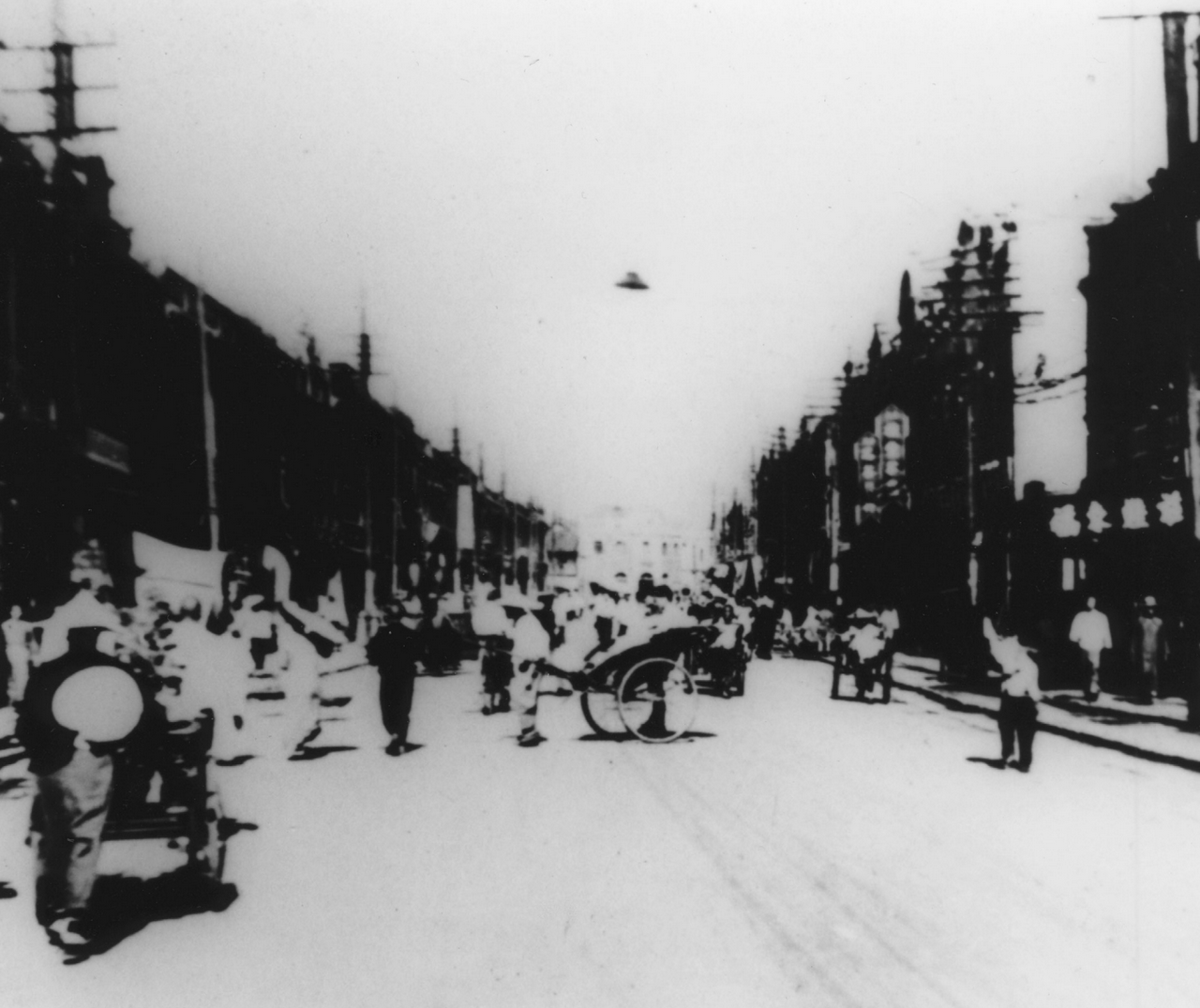
In 1942, during the Japanese occupation of northern China, a curious photograph surfaced from the city of Tientsien (now Tianjin). The black-and-white image shows a busy street scene, with several people pointing upward at a dark, hat-shaped object hanging in the sky. The fact that bystanders were caught in the act of reacting makes the photo stand out, giving the impression that whatever was overhead genuinely startled those who saw it.
The backstory of the photo is hazy. Some say it was taken by a Japanese photographer and later found in Masujiro Kiryu’s father’s wartime collection. Others suggest it might actually date back earlier, perhaps as far as 1911. Skeptics argue the object could be something mundane—a bird, a lid, or debris caught at just the right moment—but no clear answer has ever been agreed upon. Whether authentic or not, the Tianjin photo remains one of the earliest and most intriguing UFO-related images from China, combining a sense of history, mystery, and human reaction all in a single frame.
Utah / Arizona border region – 1970s
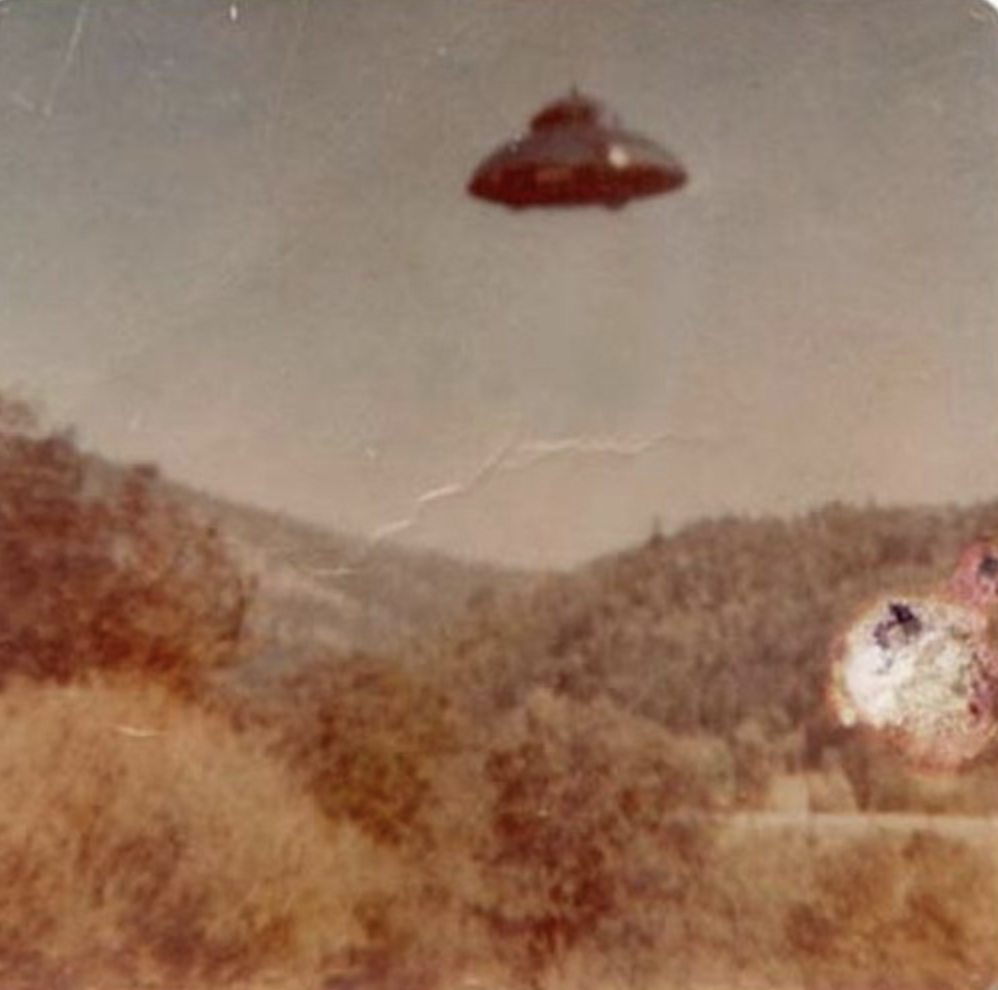
This snapshot from the 1970s shows a domed, saucer-shaped object hanging above the low hills along the Arizona–Utah border. The photo has the muted, washed-out colors typical of film from that era, with scrubby desert slopes and a pale sky in the background. According to a note attributed to Henry Rowland, the photographer’s brother was heading into the mountains when he saw the object rise from behind a ridge. He ran to the car, grabbed his camera, and managed to capture a single frame before it slipped out of sight.
The image itself is what keeps people looking twice. The object appears metallic, with a dome on top and circular features visible underneath. There’s no sign of it being tossed or suspended close to the lens, but the slightly soft focus leaves plenty of room for doubt. Like many photos from that period, it sits in a gray area—maybe a clever setup, maybe a misidentified object, or maybe something genuinely unusual. With only the one print and Rowland’s short note as context, it remains a small but persistent mystery from the desert border country.
Nashville, Tennessee – 1989
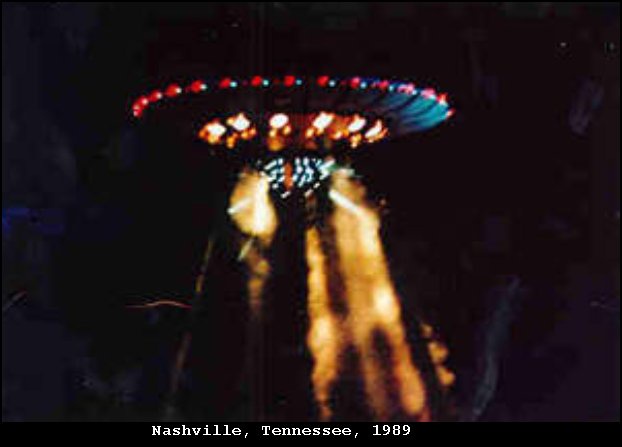
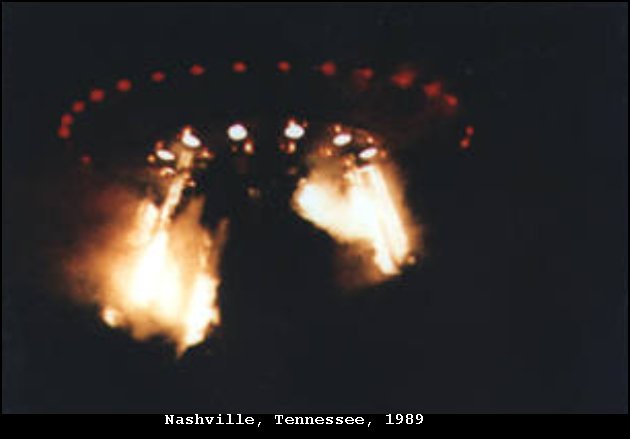
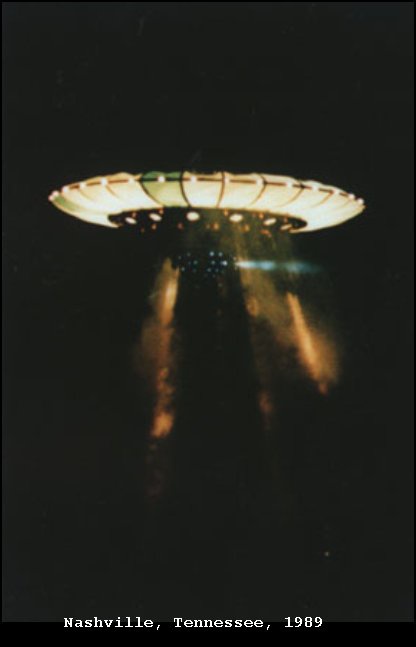
Ok, these ones are pretty wild and controversial!
The 1989 Nashville photographs show one of the more flamboyant “flying saucer” images in UFO lore. The craft captured here appears as a large brightly lit disc-shaped machine with a domed center and a glowing rim. Bright lights in red, blue, and white ring the circumference in a neat pattern
The photos surfaced through U.S. Navy Commander Graham Bethune, who said he received them from a friend that wanted to remain anonymous. A label on one surviving print reads: “Photograph taken in Nashville, TN. 9/27/89. With high magnification lenses, filters and high-speed film. Same craft different configurations.” That technical note gave the impression the photographer had deliberately worked to capture the object as clearly as possible.
Skeptics argue the images could be nothing more than staged models or theatrical props, while others consider them some of the clearest UFO shots ever published. The absence of original negatives and the mystery around the photographer’s identity only fuel the debate.
Whatever the truth, the Nashville 1989 photos remain among the most striking and hotly discussed UFO images of the era—captivating, puzzling, and impossible to ignore.
Maslin Beach, Australia – March 10, 1993
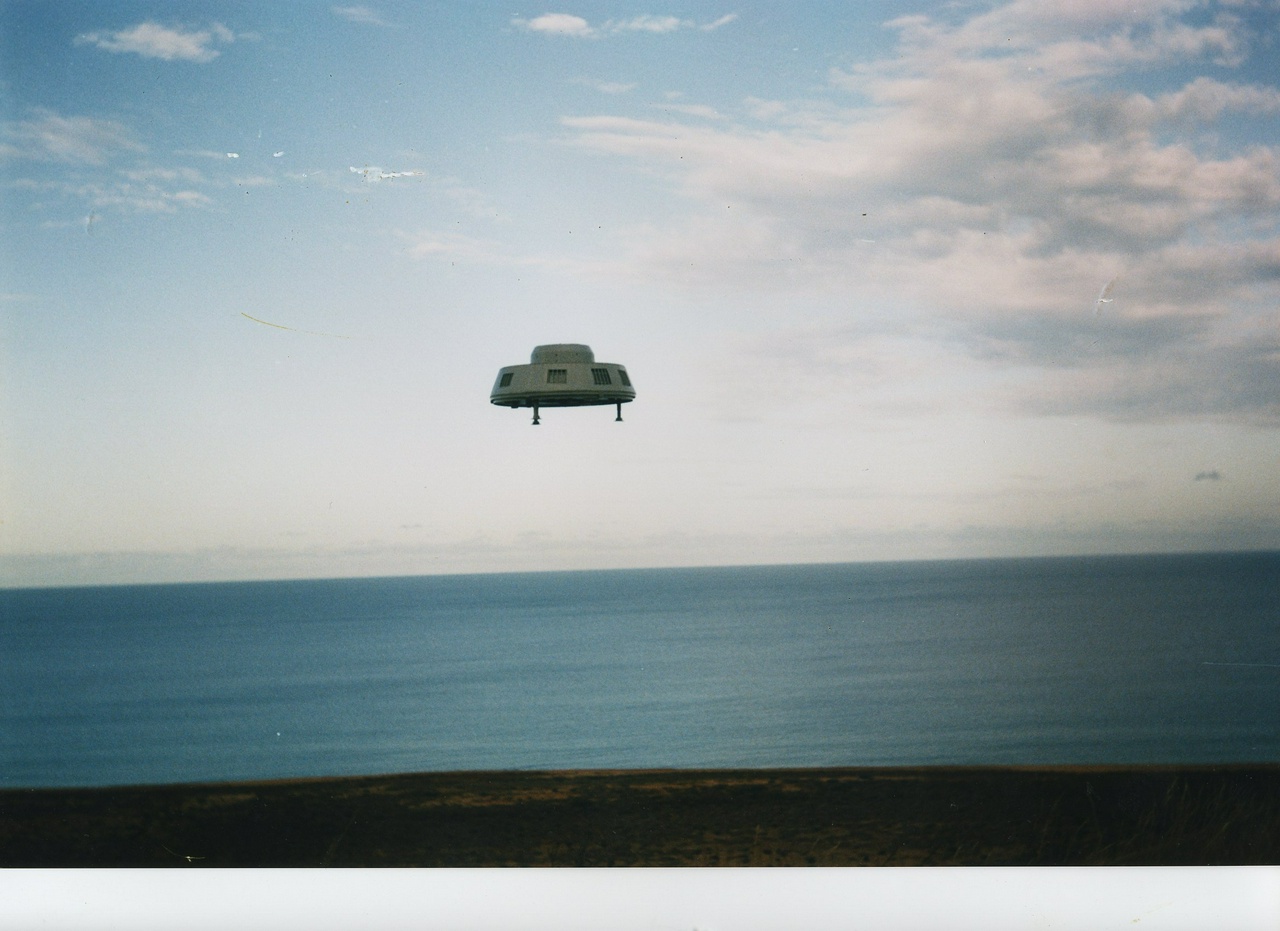
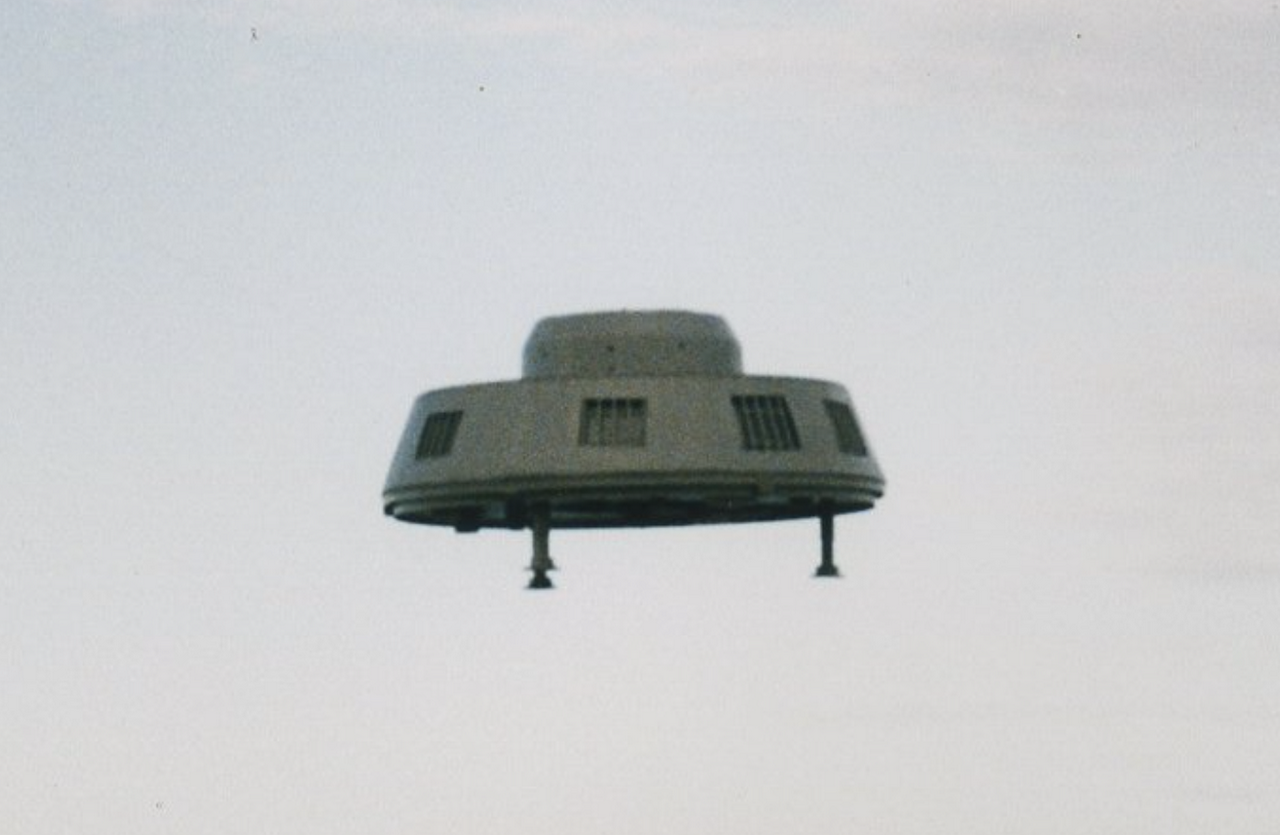
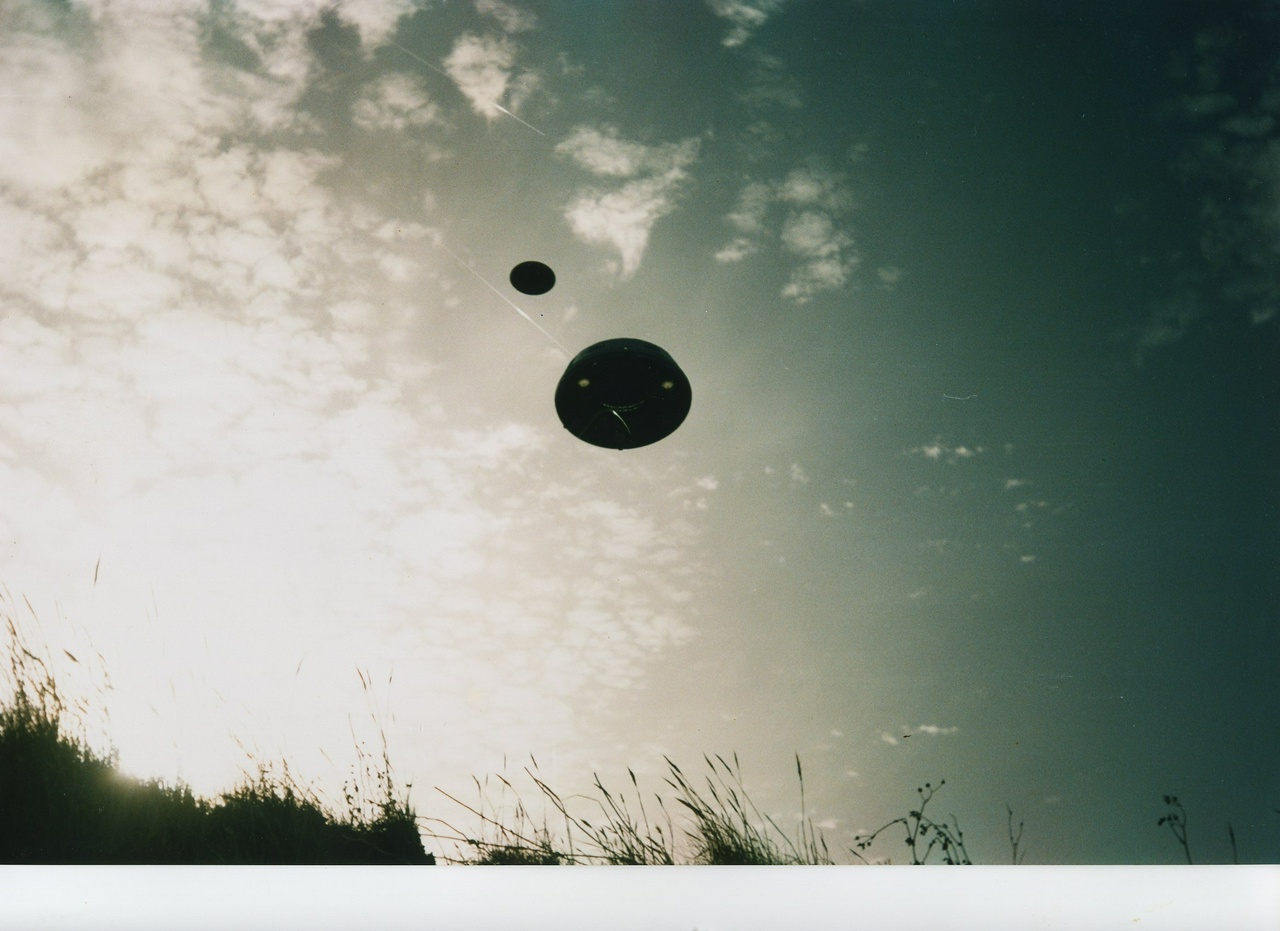
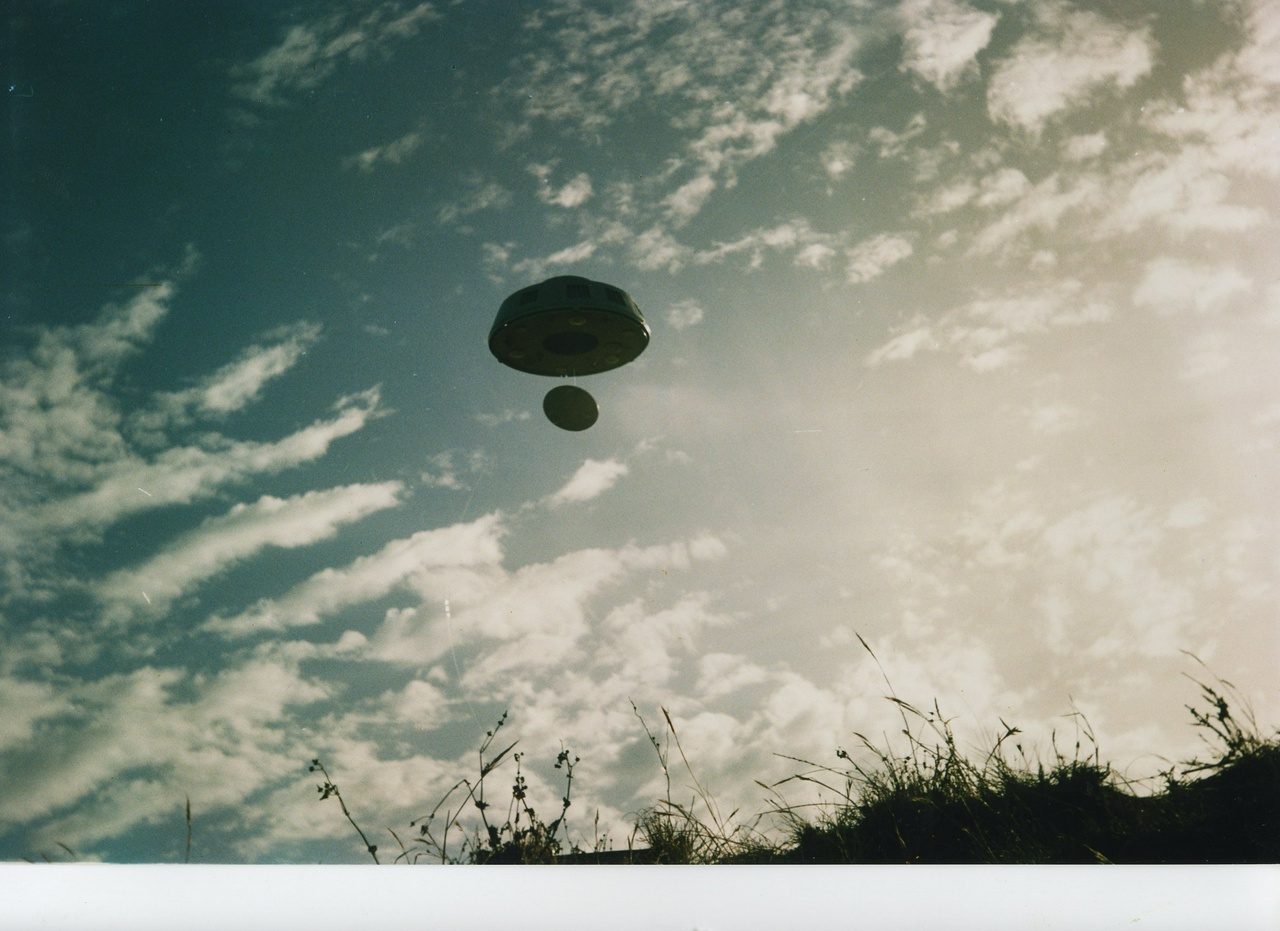
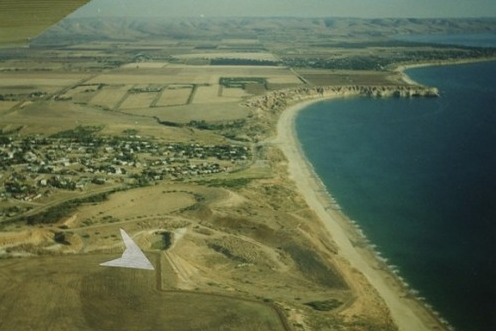
Ok, so these shots are pretty unbelievable, and if they’re genuine, they might show one of the most unusual UFOs ever captured on camera.
The first photo, with its three legs extending from the bottom, almost looks like the kind of flying saucer a kid would design if you asked them to draw a UFO. Looking closer, and you can even make out what seem to be bars across the ‘windows.’ It’s a truly bizarre and fascinating series of images.
On March 10, 1993, 69-year-old Eric Thomason set out early to photograph an old mine at Ochre Point, just south of Maslin Beach in South Australia. While standing on the cliffs, he said he saw something rising out of the ocean. At first it looked like a dark mass breaking the surface, but as it lifted higher he realized it was a huge disc-shaped craft, roughly 40 meters wide, with three legs extending from its underside and water streaming off its body.
Thomason later described how the object spun slowly above the waves before a smaller disc shot up from beneath it and merged into the larger craft. A second object then appeared from the north, approached, and both ascended vertically into the sky until they vanished. As he ran down the slope, worried it might come closer, he even felt drops of water fall on him from the rising craft.
Luckily, Thomason had brought along a Kodak S50 camera loaded with Fuji 100 ASA film. He managed to capture several photos, some of which are unusually sharp and show a clear, structured object. One frame even contained an additional smaller object he said he hadn’t noticed at the time.
The pictures drew quick attention but also plenty of criticism. Skeptics argue the Kodak S50, a fixed-focus point-and-shoot, wouldn’t have been able to capture distant objects so cleanly and that the images suggest a staged model shot at close range. Supporters counter that the detail—legs visible, water dripping, multiple craft interacting—makes this case one of the most compelling in Australia’s UFO history.
Whether staged or not, the Maslin Beach photos have become a cornerstone of Australian UFO lore. With Thomason sticking to his story for years, the sighting remains one of the most talked-about and debated cases of the 1990s.
Litchfield, Connecticut, USA – October 10, 2004
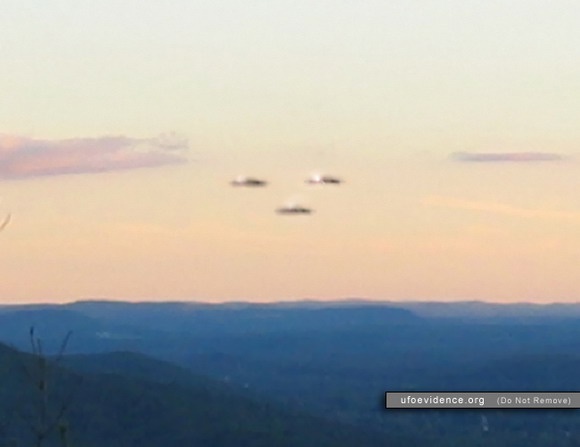
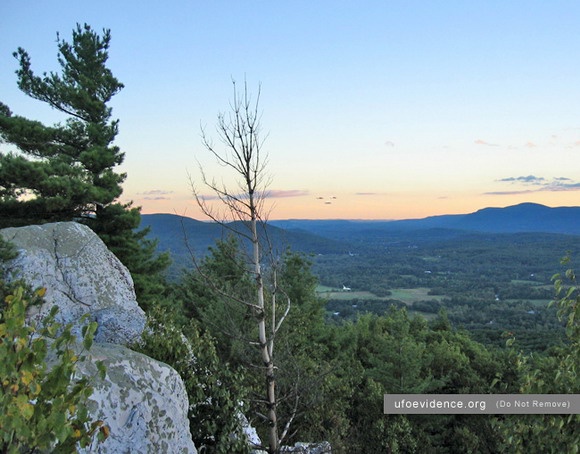
On October 10, 2004, a handful of photos appeared from Litchfield, Connecticut that seemed to show three disc-shaped objects flying in formation. The pictures, which later spread on sites like UFOEvidence.org, looked straight out of the 1940s and 50s “flying saucer” mold—clean discs hovering against the sky, lined up almost too perfectly.
The problem is that there isn’t much to back them up. The photographer has never really been identified, no negatives or high-quality originals have surfaced, and there aren’t any solid witness reports tied to the sighting beyond the date on the photos. That lack of context makes it hard for researchers to treat the case as anything more than a curiosity. Still, the images keep popping up in UFO collections because they hit that “classic saucer” look so squarely. Whether real or staged, the Litchfield photos are a good example of how an eye-catching image can stick around in UFO lore even when the details behind it are thin.
Zdany, Poland – January 8, 2006
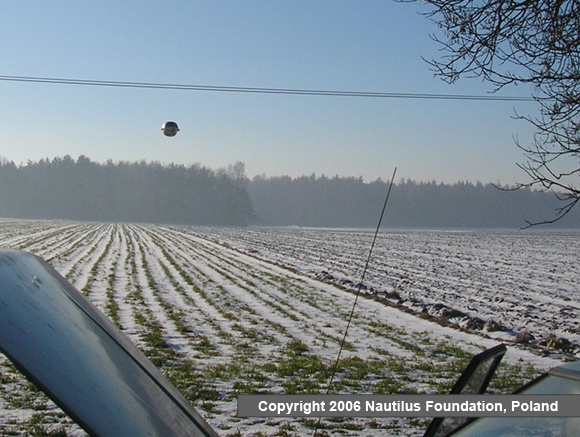
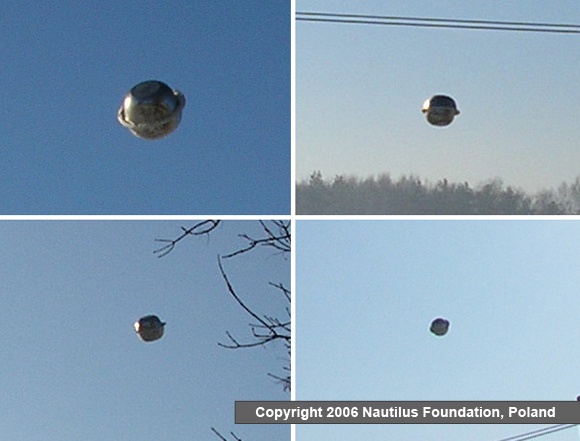
On January 8, 2006, two men driving home from a wedding near Zdany, Poland claimed their car suddenly stalled, along with a Russian minibus behind them. As they got out, they spotted a metallic, bowl-shaped craft hovering over the nearby fields. One of them pulled out a camera and snapped several photos of the object, which seemed to drift silently before shooting upward into the sky. As soon as it was gone, both vehicles reportedly started back up without issue.
The photos quickly spread and became one of Poland’s best-known UFO cases. Supporters highlight the reflective surface of the craft and the strange vehicle failures as signs something unusual happened. Skeptics, on the other hand, point out the object looks suspiciously like two mixing bowls stuck together and suggest it could have been a model thrown or suspended close to the lens. Without the negatives or any solid metadata, the photos are impossible to verify, leaving Zdany as one of those cases where believers see rare proof and critics see a simple staged trick.
Waterbury, Connecticut – 1987
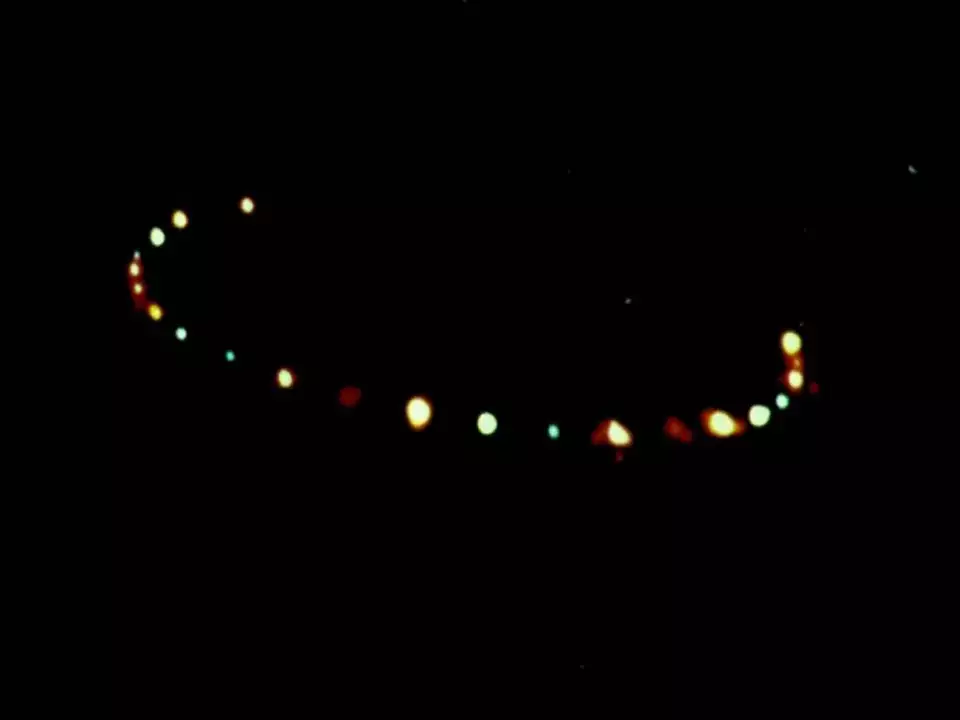
The Waterbury, Connecticut UFO photo from 1987 is one of those classic cases that people still talk about. The shot shows a wide arc of glowing red, green, yellow, and white lights stretched across the night sky, almost like the outline of a massive curved craft—though all you can actually see are the lights themselves.
What gives this photo a bit more credibility is who took it. A police officer snapped the picture while driving along Route I-84 near Waterbury. He said the lights were hanging low, spread out in a formation that looked far too big and deliberate to chalk up to chance.
Of course, not everyone buys it. Some argue it’s just a long-exposure photo of regular aircraft lights or maybe even reflections. But others point out the scale of the formation and say it suggests something much larger, something we can’t easily explain.
Decades later, the Waterbury photo still stands out as one of the most striking nighttime UFO images of the 1980s. It’s often mentioned in the same breath as the Hudson Valley sightings from around the same time, which also featured those eerie arcs of multicolored lights drifting over the Northeast.
Cluj, Romania – 1968
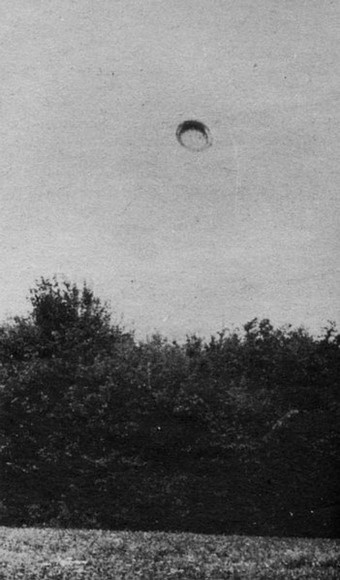
Cluj, Romania, 18 Aug 1968. Emil Barnea was picnicking with his girlfriend and two friends in the Hoia-Baciu Forest when a silent, disc-shaped object slid over the treetops. He grabbed his FED-2 rangefinder and fired off four shots in quick succession from the Poiana Rotundă clearing. The sequence shows a classic saucer profile in daylight, brightening and canting slightly before it seems to pull away.
The photos ran a month later in the Romanian press after agency technicians said the negatives didn’t show obvious trick work. Local astronomers floated the idea of a weather balloon photographed at a strange angle. Others pointed to the highlights on the craft and argued it looked self-luminous rather than just reflecting sunlight. Barnea’s story came with a cost in communist-era Romania, which only added to the legend.
Whether you lean balloon, hubcap thrown in the air, unknown, the combination of a clean daylight sequence, a named photographer, and a traceable publication trail is why this one still makes the shortlists.
Sicily, Italy – Dec 10, 1954
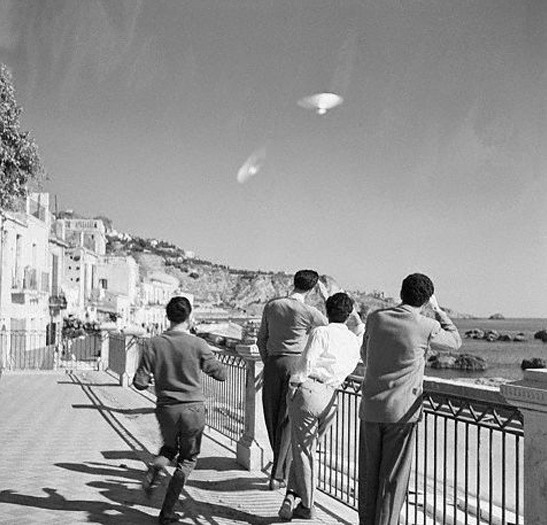
December 10, 1954, Sicily. On a seaside street, four men look up from the beach promenade, watching two small disc-shaped lights hang over the waterline. The scene feels calm and a little eerie, the pair of lights holding steady while the onlookers try to make sense of them.
The photo moved on the news wires during a busy run of European sightings. Reporters checked in with the photographer, who said the objects were in the sky and stayed nearly motionless for several minutes. Around the same time, the U.S. Air Force said it was looking into the latest accounts, which helped this image get wider circulation and keep its place in the 1954 wave.
Woonsocket, Rhode Island, USA – Jun 10, 1967
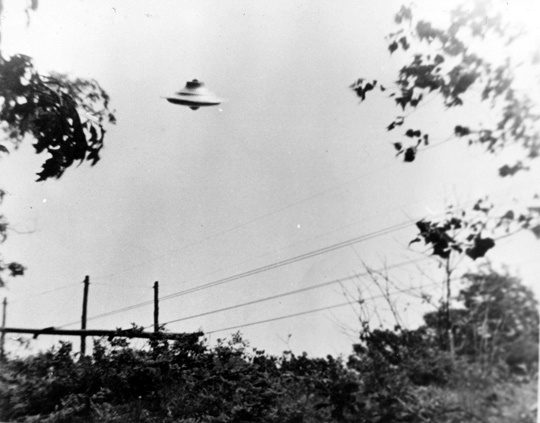
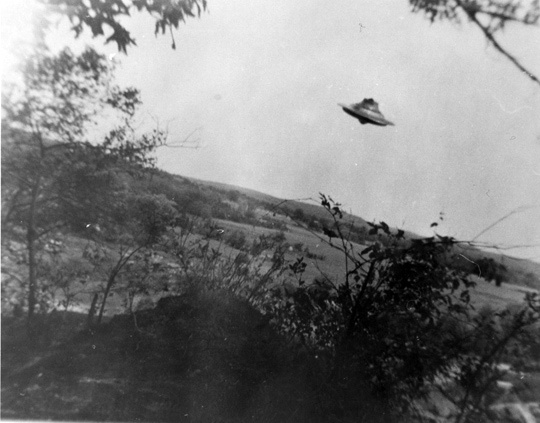
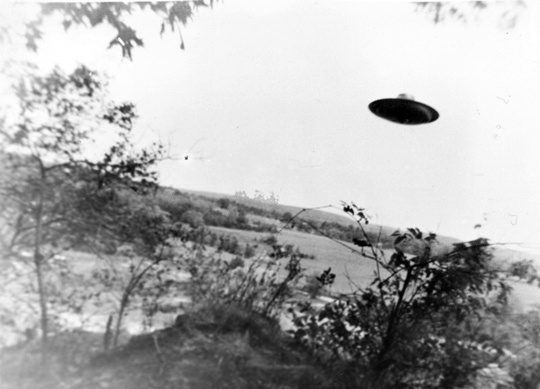
Woonsocket, Rhode Island, summer 1967. Local resident Harold Trudel photographed a domed disc hanging over the power lines near his neighborhood on June 10 at midday. In the first frames a small antenna-like nub is visible under the craft, and the object appears to idle rather than streak.
He returned on June 16 and caught what looks like the same thing again, this time without the little protrusion. On July 11 he photographed a third pass over the same stretch of lines. Local retellings tie that last sighting to a power cut that hit around 19,000 customers about twenty minutes later.
What keeps these shots in circulation is the mix of repeat daylight photos, the unmistakable power line backdrop, and the way it echoes other New England reports from the era that mentioned objects lingering near the wires. Whether you think that’s coincidence or a clue, the Woonsocket series still feels like a time capsule from the classic saucer years.
Waupaca, Wisconsin – Sep, 2004
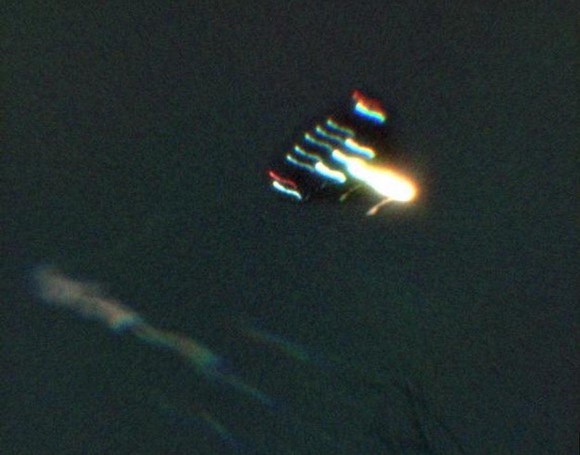
Shot just after sunset on September 22, 2004, reportedly by Jeff P. The object was moving west to east. That’s the extent of the record I could trace.
At first glance it looks like a jet, maybe a fighter, but the shape and lighting are unusual. If I find out more about the source or this photo, I’ll add it at a later date.
Experimental military craft?
Rachel, Nevada – 2012 (near Area 51)
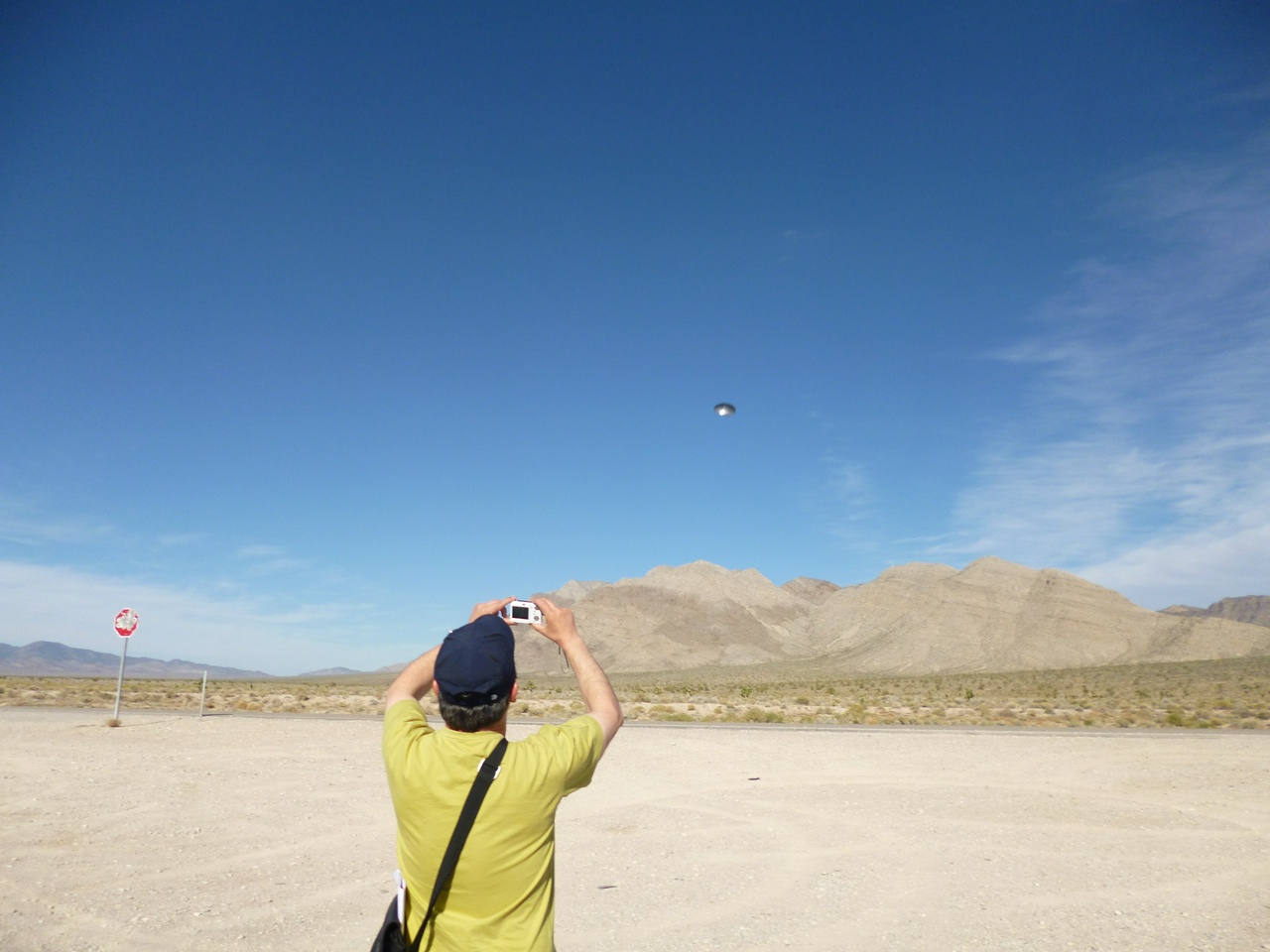
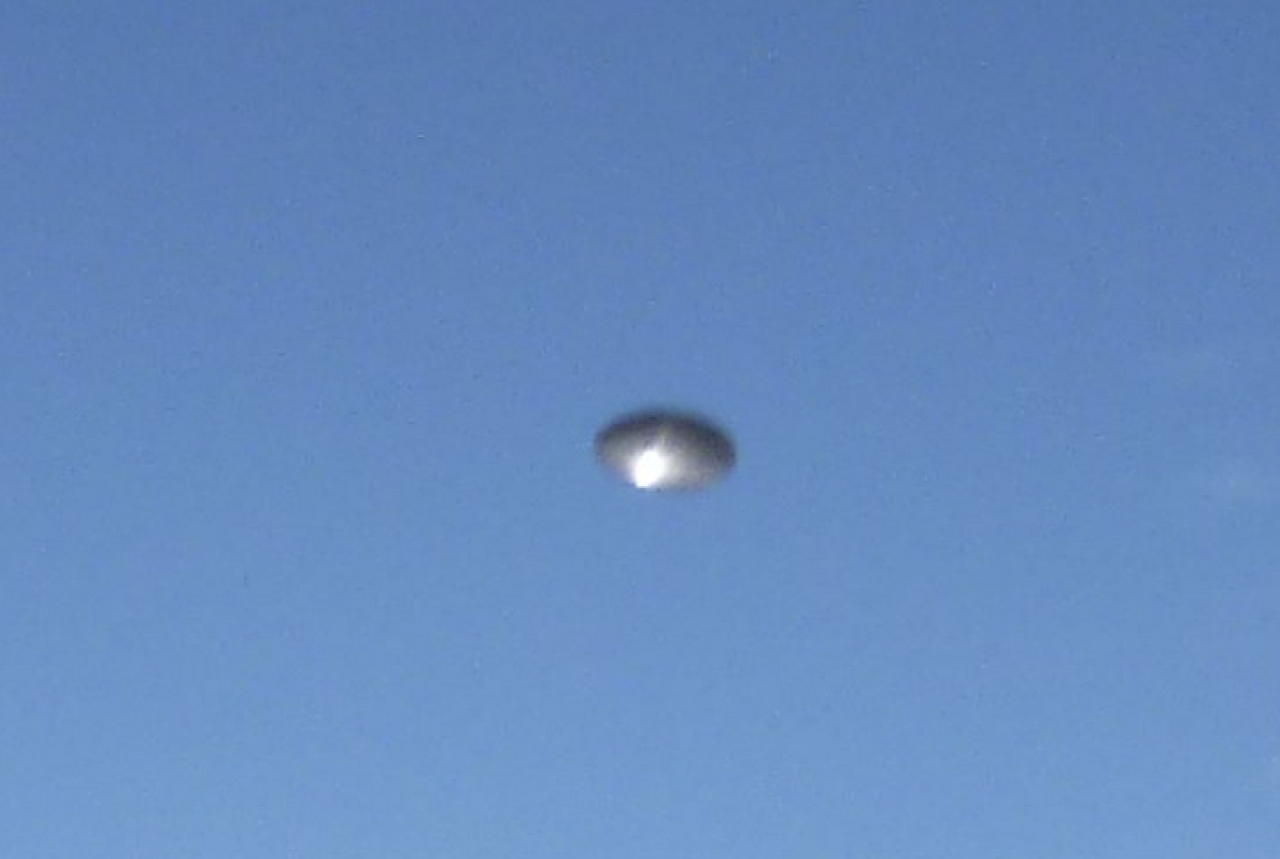
This photo was taken near the famous black mailbox on the road leading to the Area 51 gate, just outside Rachel, Nevada. A small group of tourists had stopped there after leaving town.
While they were milling around the mailbox, one of the group suddenly shouted and pointed skyward. Cameras came out quickly, and several managed to snap photos of a shiny object overhead. It hovered for a few seconds, drifted back and forth in different directions, and then, after about half a minute, shot off at an incredible speed.
Earlier in the day they’d noticed a helicopter circling the area, and a couple of them were convinced a man in a blue car had been following them along the highway.
Karagol near Izmir, Turkey – Feb, 1998
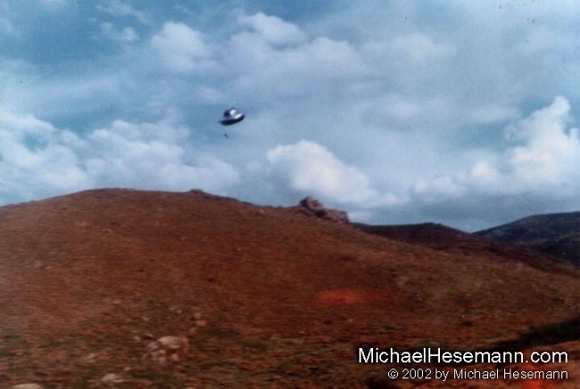
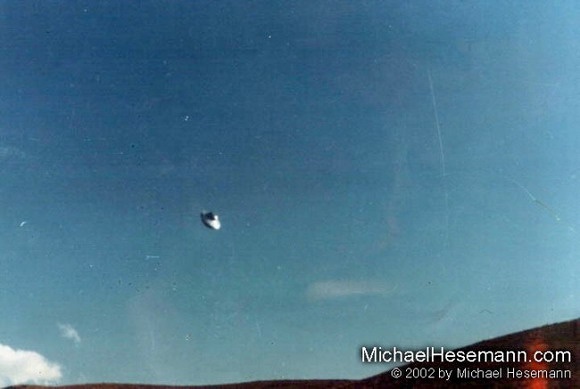
In February 1998, two friends, Cem Arat and Mehmet Safak, captured a pair of remarkable UFO photos while visiting Yamanlar Mountain Peak near Karagöl, Turkey. They had returned to the site many times after earlier sightings, and on what they called their “farewell trip” before military service, they once again encountered a fast-moving object in the sky.
Only two frames managed to capture the craft, but both were later examined by experts. Dr. Ahmet Imancer of Aegean University concluded the photos were not a hoax, estimating the object to be around 20 meters across and roughly 500 meters away. Further analysis in Istanbul confirmed the negatives showed no signs of tampering.
These photos remain among the most notable UFO cases from Turkey, backed by multiple independent examinations and the persistence of the original witnesses.
Suonenjoki, Finland – March 16, 1979
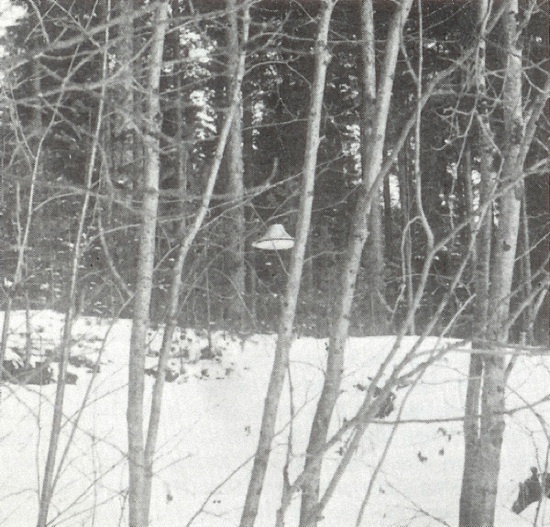
The Suonenjoki region of Central Finland saw a series of UFO encounters stretching across much of the 1970s. The main witness, electrician Jarmo Nykänen, first reported strange lights and close encounters as early as 1973, including a glowing blue mass over a lake that left him disoriented and unusually tired. In the years that followed, odd disturbances continued: knocking sounds at night, strange lights, and by 1979, physical traces in the snow.
That winter, several landing sites were discovered near the home of another local resident, Reijo Kolehmainen. These sites included melted snow craters, pools of red liquid that smelled of vinegar, and small metallic fragments. Police investigated, took samples, and even suggested homemade explosives, though the family insisted there was no reason anyone would target them. The events quickly gained local press coverage and drew interest from UFO researchers.
On March 16, 1979, Nykänen set out with his camera and binoculars to monitor the area. While walking through the forest near his cottage, he encountered a small bell-shaped craft, glowing blue and red, hovering just above the snow. He reported it moved in sudden bursts, sometimes descending close to the ground, and at one point even directed a red beam of light toward his face. Nykänen said he captured twelve photographs during the encounter, though only one image — this photo taken in the forest — has surfaced publicly.
Between the photo, the physical trace evidence, and police involvement, the Suonenjoki case remains one of the most thoroughly documented UFO incidents in Finnish history.
Kumburgaz, Turkey – 2007-2009
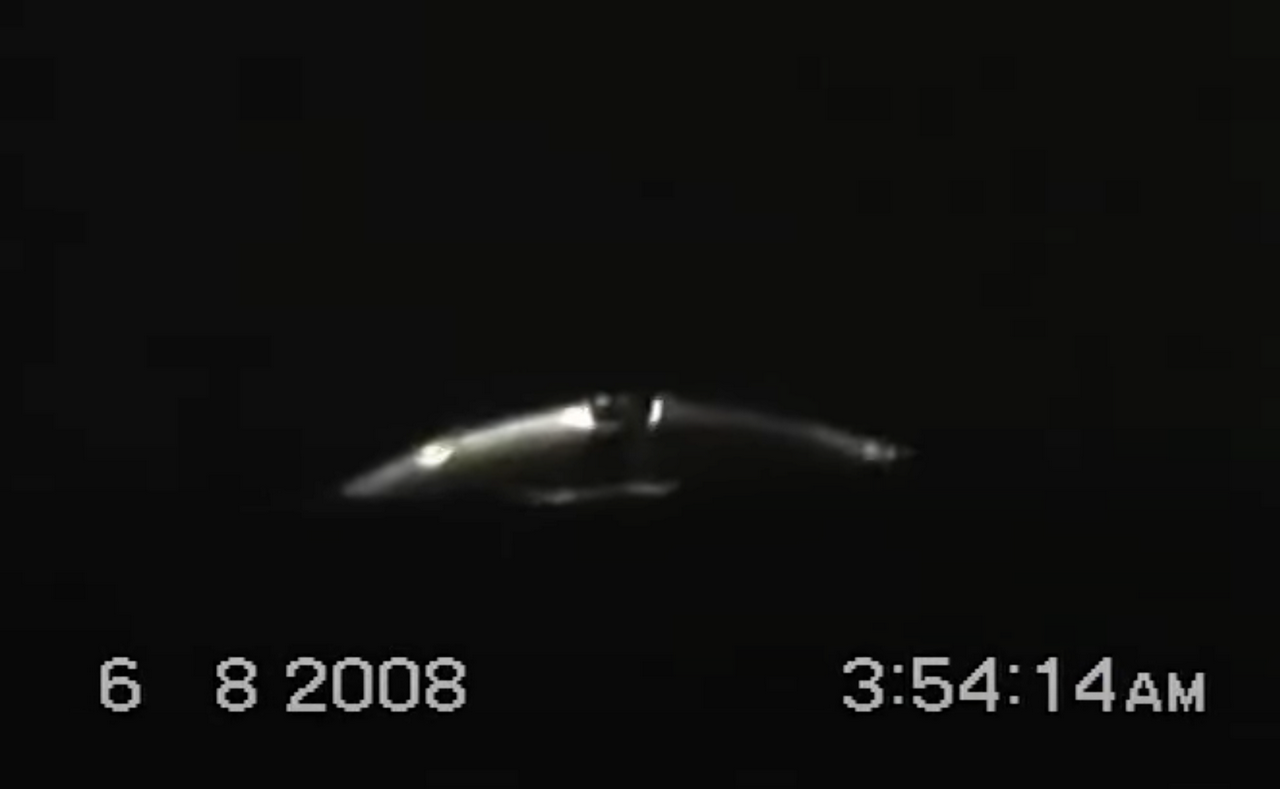
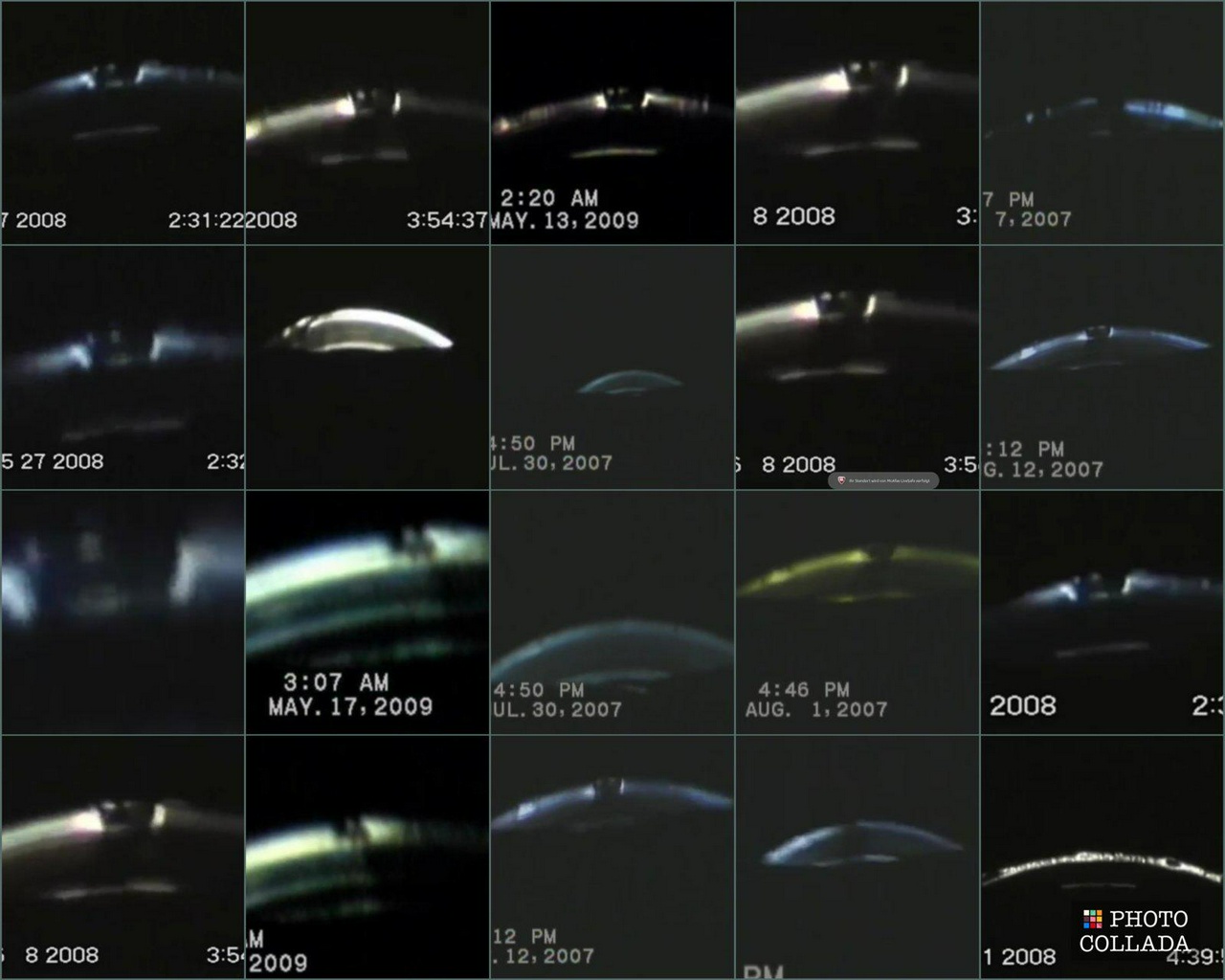
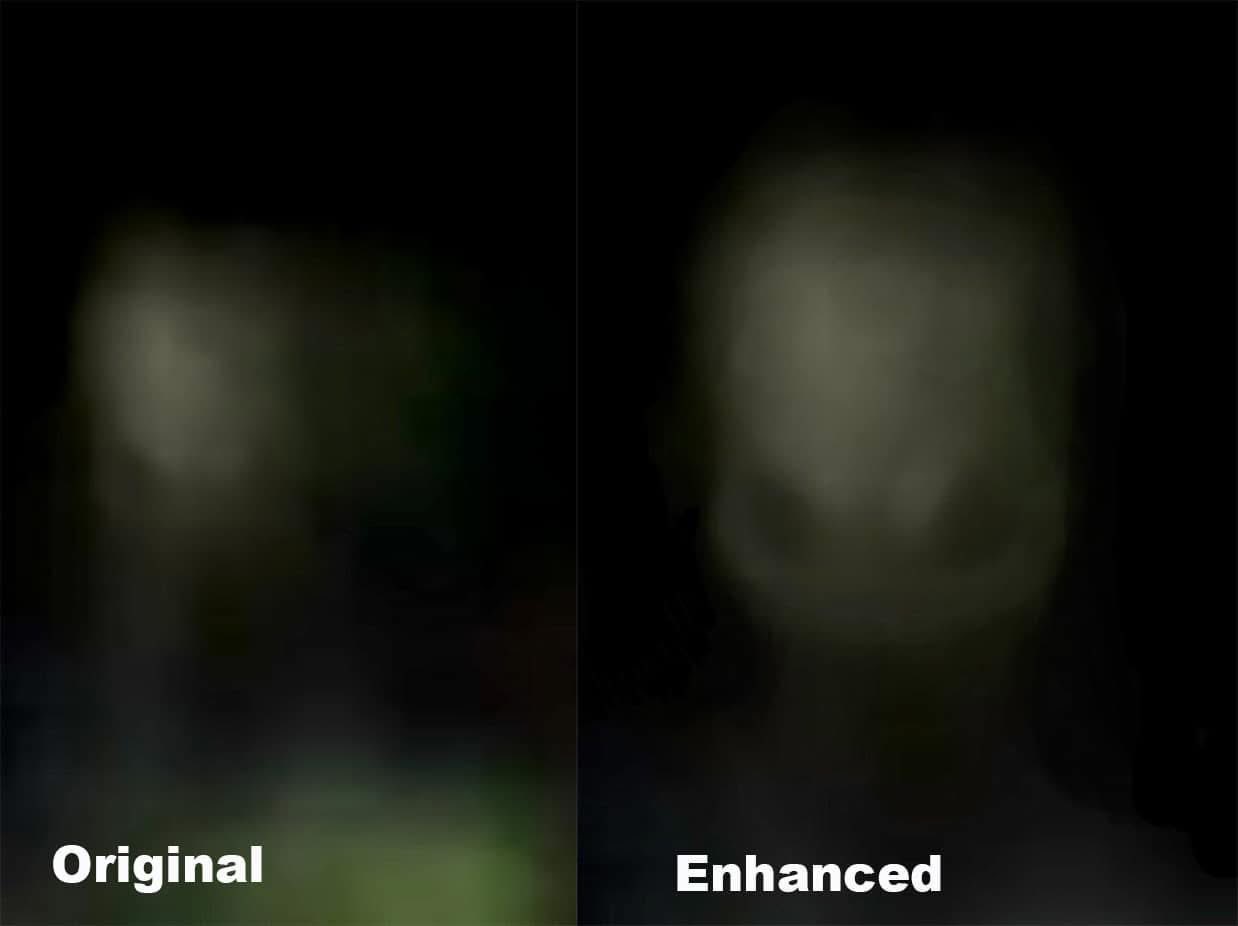
Along the Marmara coast, a night guard named Yalçın Yalman recorded a series of UFOs between 2007 and 2009. Using a high-zoom camcorder, he captured objects hovering over the sea, sometimes showing metallic structure and unusual movements. The videos were studied by SIRIUS UFO Research and later by TÜBİTAK, Turkey’s national scientific body, which found no evidence of CGI, models, or tampering.
Some researchers claim the footage shows humanoid figures inside the craft, pointing to large heads and dark eyes, while others even describe an insect-like form. But the recordings are very blurry, and whether these figures are truly visible or just artifacts of light and shadow remains open to interpretation. It’s also important to note that many AI-upscaled versions circulating online add details that were not present in the original footage, so caution is needed when evaluating them.
Despite the controversy, no definitive conventional explanation has ever been given, making the Kumburgaz videos one of the most debated UFO cases of the 21st century.
Final Thoughts
From sleepy farms in Oregon to the skies over Belgium, these photos have done something few things in UFO history manage to do: survive the endless onslaught of “experts” yelling swamp gas, lens flare, Chinese lanterns, or the always reliable “seagull caught mid-blink.”
Yeah, some are probably hoaxes, like a hubcap hanging on fishing line. But if even one of them is real, the biggest mystery in human history has been sitting in plain sight while skeptics bend themselves into Olympic-level gymnastics trying to explain it away with cloud reflections and camera wobble.
So here’s the deal: believers will see saucers, skeptics will see birds, and Mick West will see a weather balloon riding on the back of a duck. But at the end of the day, it only takes one real photo to flip the whole conversation on its head. And if that happens, you better believe the skeptics will still be there, squinting at the evidence, insisting it’s “probably just Venus.”
I’ll leave you with this thought:
What if just one of these photos is real?
That’s all it would take to change everything we think we know.
WE BELIEVE.
Check my other posts
Was Flight MH370 Teleported?
My detailed analysis of the plane and orb teleportation videos that some people have linked to the disappearance of MH370.
Why Is Skinny Bob Still Blinking at Us?
A look at the “Skinny Bob” alien footage, where I break down why it’s so strangely convincing, what’s likely fabricated, and why the videos still spark debates years later.
Did a 2024 Forgotten Languages Post Foreshadow The Nordic Drone Crisis?
A breakdown of a cryptic Forgotten Languages post about a supposed drone strike simulation off New Jersey, and how its details later echoed the real drone shutdowns across Denmark, Norway, and Germany. I compare the timeline, the political backdrop, and the odd overlap between fiction, leaks, and NATO airspace incidents.
Carlos Díaz: The UFO with the Glowing Molten Skin
A detailed look at the Carlos Díaz “Ships of Light” UFO: the molten amber craft he photographed over Ajusco, how it seemed half-machine, half-alive, and why the visuals still rank among the most striking UFO images ever captured, hoax or not.
The “Flyby” UFO Footage: And Why It Refuses to Fade Away
A deep dive into the 2008 “Flyby” UFO video, where a disc-shaped object appears to following an airliner (or jet?), and why this short, grainy clip still sits in that uncomfortable space between what is could be a clever hoax, or genuinely a real UFO.
Follow me on X for more updates.
